
About UsThe Numismatic Bibliomania Society is a non-profit organization devoted to the study and enjoyment of numismatic literature. For more information please see our web site at coinbooks.org SubscriptionsThose wishing to become new E-Sylum subscribers (or wishing to Unsubscribe) can go to the following web page link MembershipThere is a membership application available on the web site Membership Application To join, print the application and return it with your check to the address printed on the application. Membership is only $20 to addresses in the U.S., $25 for First Class mail, and $30 elsewhere. For those without web access, write to: David M. Sundman, Treasurer
AsylumFor Asylum mailing address changes and other membership questions, contact David at this email address: dsundman@LittletonCoin.com SubmissionsTo submit items for publication in The E-Sylum, just Reply to this message, or write to the Editor at this address: whomren@gmail.com BUY THE BOOK BEFORE THE COIN |
- WAYNE'S WORDS: THE E-SYLUM JANUARY 18, 2015
- 3& FANNING 2015 NEW YORK BOOK AUCTION RESULTS
- SKLOW MAIL BID SALE #24 CLOSES FEBRUARY 7, 2015
- NEW BOOK: THE 1838-O HALF DOLLAR
- NEW BOOK: MONETARY HISTORY OF BERN IN THE MIDDLE AGES
- NEW BOOKS: NUMISMATICA CATALOG, LEBANESE TOKENS
- NEW BOOK: KEEP THE CHANGE
- ANS NAMES PUBLICATIONS DIRECTOR, PLANS DIGITIZATION
- COINAGE OF THE ROMAN REPUBLIC ONLINE
- PORTRAITS OF DECEASED FAMOUS NUMISMATISTS
- FIVE BOOKS DAVE BOWERS SHOULD WRITE
- MORE ON MACERATED CURRENCY
- THE TRUMAN CONGRESSIONAL GOLD MEDAL
- NOTES FROM E-SYLUM READERS: JANUARY 18, 2015
- SALLY KIRKA'S NUMISMATIC LITERARY GUILD ELONGATED COINS
- BOOK: 200 YEARS OF BALLOONING IN NUMISMATICS
- ARTICLE DISCUSSES KEVIN LIPTON'S BIRCH CENT PURCHASE
- ARTICLE PROFILES DEALER DON KAGIN
- BEP CHIEF COUNSEL SIDNEY ROCKE
- NUMISMATIC SCRAPBOOK CONTRIBUTOR'S MEDAL IMAGES
- MORE ON THE 1864 BOSTON MASONIC TEMPLE HALF DOLLAR
- ROYAL MINT UNVEILS £20 WINSTON CHURCHILL COIN
- ROGER BLAND AWARDED ROYAL NUMISMATIC SOCIETY MEDAL
- ROOSEVELT MEDALS FASCINATE A COLLECTOR
- THE SCANDALOUS BOHEMIANS OF NEW JERSEY MEDAL
- WAYNE'S NUMISMATIC DIARY: JANUARY 18, 2015
- JEFF STARCK REVIEWS EMERGENCY COINAGE
- HOWARD GIBBS AND HIS ALASKAN TINNAH
- POMPEII WALL PAINTING DEPICTS ANCIENT COIN MINTING OPERATION
- SOME RECENT COIN DESIGNS: JANUARY 18, 2015
- HISTORIAN PANS MAGNA CARTA COIN DESIGN
- ROYAL MINT'S BIG BEN COIN SELLS OUT
- SALES OF PHYSICAL BOOKS SURGE; E-BOOKS LAG
- EMPEROR NORTON'S TELEVISION APPEARANCES
- TWO DOLLAR BILLS FOR THE YEAR OF THE GOAT
- "BLACK JESUS" DISTRIBUTES COUNTERFEIT MONEY
- 'IN DOG WE TRUST' RUG FOR SALE
- FEATURED WEB PAGE: DIGITAL LIBRARY NUMIS
Click here to access the complete archive
To comment or submit articles, reply to whomren@gmail.com
WAYNE'S WORDS: THE E-SYLUM JANUARY 18, 2015

New subscribers this week include John Sculley, courtesy of Mark Borckardt; and Harley J. Spiller. Welcome aboard! We now have 1,814 subscribers.
This week we open with updates from two numismatic literature dealers, five new books, and some important announcements from the American Numismatic Society.
Other topics include deceased famous numismatists, the Truman Congressional gold medal, a monster-sized Centennial medal, balloon medals, dealers Kevin Lipton and Don Kagin, the Boston Masonic Temple half dollar, emergency coinage, Deutschen Schaumünzen, und Emperor Norton's television appearances.
To learn more about Inspector Collector, the 1838-O Half Dollar, Lebanese tokens, Numismatic Immortality, the Royal Numismatic Society medal, the Scandalous Bohemians of New Jersey, a creepy-looking beaver, Mr T and The Bank Manager Who Throws Away a Grand a Year, read on. Have a great week, everyone!
Wayne Homren
Editor, The E-Sylum
KOLBE & FANNING 2015 NEW YORK BOOK AUCTION RESULTS
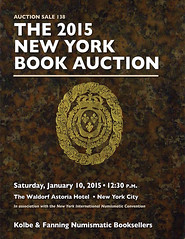 Kolbe
& Fanning Numismatic Booksellers held their 2015 New York Book Auction on Saturday, January 10, 2015 at the Waldorf-Astoria Hotel in conjunction
with the New York International Numismatic Convention (NYINC). The sale featured a variety of impressive numismatic works covering ancient, medieval,
modern foreign and United States coins and medals. Some sale highlights are as follows:
Kolbe
& Fanning Numismatic Booksellers held their 2015 New York Book Auction on Saturday, January 10, 2015 at the Waldorf-Astoria Hotel in conjunction
with the New York International Numismatic Convention (NYINC). The sale featured a variety of impressive numismatic works covering ancient, medieval,
modern foreign and United States coins and medals. Some sale highlights are as follows:
--The extremely rare 1682 first issue in book form depicting the Sun King’s collection of ancient coins (lot 156) brought $20,060 (all prices include buyer’s premium).
--Perhaps the finest existing deluxe copy of Browning’s 1925 work on early U.S. quarter dollars, one of only five bound in full morocco (lot 230), brought $21,240.
--An exceptional volume of 1790s pamphlets by Augustin Dupré regarding his role in French coinage, from the author’s own library (lot 112), brought $6490.
--A superb, richly gilt, deluxe leatherbound set of the virtually unknown 1881 edition of Loubat’s Medallic History of the United States (lot 281), brought $12,980.
--A fine set of Edward Cogan sales (lot 250), derived from the Fuld set and substantially augmented by a subsequent owner, brought $8260, while the Fuld set of Lyman Low catalogues (lot 282) brought $7670.
--A fine set of Haeberlin’s Aes Grave (lot 36) brought $5750.
--A set of Raczynski’s rare work on Polish coins (lot 178) brought $5310.
--Gnecchi’s magnificent work on Roman medallions (lot 34) brought $4887.50. --A fine set of Habich’s rare Deutschen Schaumünzen (lot 126) brought $4720.
--A set of all three limited presentation edition Bowers & Ruddy/Merena catalogues (Garrett, Norweb, Brand/Eliasberg; lot 228), brought $4130.
The sale included many other notable works not mentioned above, including rare books on ancient coins, important publications on medals, and extremely rare photographically illustrated U.S. auction catalogues.
A PDF of the catalogue and the PRL can be downloaded from the Kolbe & Fanning website at www.numislit.com.
Kolbe & Fanning thank all those who participated in the sale and look forward to the rest of 2015!
David F. Fanning, Ph.D.
Kolbe & Fanning Numismatic Booksellers LLC
141 W. Johnstown Rd.
Gahanna, OH 43230
(614) 414-0855
Cell (614) 256-8915
Fax (614) 414-0860
df@numislit.com
www.numislit.com
Members ANA, ANS, IAPN
SKLOW MAIL BID SALE #24 CLOSES FEBRUARY 7, 2015
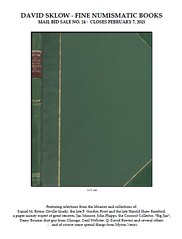 David Sklow-Fine Numismatic Books will have its MBS # 24 closing on February
7, 2015 at 8 PM. Bidding will be via Email, Telephone, Fax and Mail, bids will be accepted that are received by Email, Fax or Telephone message up to
midnight on closing day. There are NO changes to the terms of sale. The sale consists of over 1000 lots of a well diversified nature, Featuring
selections from the libraries and collections of: Daniel M. Byrne, Orville Grady, the late F. Gordon Frost and the late Harold Shaw Bareford, a paper
money expert of great renown, Jan Monroe, John Phipps, the Coconut Collector, "Big Jim", Remy Bourne, that guy from Chicago, Cecil Webster,
Q. David Bowers and several others.... and of course some special things from Myron Xenos .
David Sklow-Fine Numismatic Books will have its MBS # 24 closing on February
7, 2015 at 8 PM. Bidding will be via Email, Telephone, Fax and Mail, bids will be accepted that are received by Email, Fax or Telephone message up to
midnight on closing day. There are NO changes to the terms of sale. The sale consists of over 1000 lots of a well diversified nature, Featuring
selections from the libraries and collections of: Daniel M. Byrne, Orville Grady, the late F. Gordon Frost and the late Harold Shaw Bareford, a paper
money expert of great renown, Jan Monroe, John Phipps, the Coconut Collector, "Big Jim", Remy Bourne, that guy from Chicago, Cecil Webster,
Q. David Bowers and several others.... and of course some special things from Myron Xenos .
Some highlights of the sale are:
- The Fabulous Library of Daniel M. Byrne covering Military Awards, Decorations & Medals.
- 1929 ANA Chicago Convention Photograph.
- 1937 ANA Washington, D.C. Convention Photograph.
- Historie Des Romans Depuis Les Temps Les Plus Recules Jusqu'a A L'invasion Des Barbare Vol II-VII, 1880 first edition by Victor Duruy.
- B. Max Mehl's Fiftieth Sale Catalog inscribed to Harold Bareford by Mehl, with Bareford's original bid sheets tipped in.
- Long run of Director of the U.S. Mint Reports.
- Abe Kosoff Memorabilia.
- Long run of Coinage of the Americas Conference Works.
- Limited Edition Numbered 82 of 182, State Copper Coinage 1785-1788, the Taylor Collection Photographic Plates by Bowers and Merena, 1988.
- Long run of hardbound Bowers and Merena Auction Catalogs.
- Eckfeldt and Du Bois, 1851 second edition, New Varieties of Gold and Silver Coins, Counterfeit Coins, and Bullion........
- Heath Counterfeit Detector, pocket edition, 1870, third edition, 11 plates, Newman Type 3-P.
- Heath Counterfeit Detector, 1877, twelfth edition, 10 plates, Newman variety 12-P-3.
- History of the First Mint, 1924 first edition.
- Deluxe edition, Albert A. Grinnell Collection by Barney Bluestone, 1944-1946.
- History of the Currency of the Country and of the Loans of the United States from the Earliest Period to June 30, 1900, second edition by William F. De Knight. RARE.
- Heath Counterfeit Detector, pocket edition [first] 1864, 10 plates, Newman Type 1-P.
- Heath Counterfeit Detector, Banking House edition, 1866 second edition, 12 plates, Newman 2-BH-4.
- Heath Counterfeit Detector, several other examples.
- Lee F. Hewitt's Personal copy of the William P. Donlon Collection, Deluxe Hardbound Numbered edition 1956 by Kosoff.
- Original Mason's Coin & Stamp Collectors' Magazine. Volumes I-III, 1867-1870.
- Deluxe Hardbound Limited Edition The Wayte Raymond Collection Parts I-IV. 1977-1978 by NASC, only 53 were produced.
- Numbered and Stamped MPC Fest XV edition 11 of 40, American Red Cross in World War II Collectors' Guide.
- The Romance And Tragedy of Banking, 1922, by Thomas P. Kane.
- Petersons' Complete Coin Book. 1859. by T.B. Peterson.
- A Run of Commemorative Medal books by Robert R. Heath.
- Original 1878 two volume The Medallic History of the United States of America, by Loubat, J.F.
- A complete set 1935-1976 of The Numismatic Scrapbook, 1935-1946 uniformly bound, 1947-1976 in original wrappers.
- Long run of volumes of the Canadian Antiquarian & Numismatic Journal 1877-1933.
- Canadian Numismatic Association, The CNA Bulletin 1950-1955 complete.
- Canadian Numismatic Association Journal, Volume 1-44, 1956-1999.
- Run of Interesting Notes, by Roger Durand.
- Nice group of Treasure, Sunken Ships, Wrecks and Diving works.
- Several Deluxe Hardbound Catalogs from Heritage.
- Frossard and Hays, 1910 Gilbert/Elder edition on 1794 Cents, w/4 pls.
- Stacks Reed Hawn Sale, 1993, Limited Edition No. 5 of 20.
- Decorations Officielles Francaises, 1956, 72 plates, 1962 supplement tipped in.
- The Interallied Victory Medals of WW I, second edition 1992, by Alexander Laslo.
- Das Ordenbuch Der Gewesenen Osterreichisch - Ungarischen Monarchie, 1918-1919, 26 exquisite elephant folio plates.
- Awards & Decorations of U.S. State Military Forces, 1988, by Gregory Ogletree.
- A Long Run of deluxe Hardbound Sale Catalogs of George Frederick Kolbe 1981-2000.
- ANA - First Strike: The Magazine for Young Numismatists, 1987, Vol. I No. I.
- Myron Xenos's Inventory Copy of Gengerke American Numismatic Auctions, 1990.
- The Growth of Chicago Banks 1816-1938, two volume set, 1938, by F. Cyril James.
- Numerous Special Edition Redbooks by Yeoman/Bressett.
- Run of Leather Bound Redbooks.
- Very nice run of Early volumes of the Numismatist 1894- 1921.
- Numismatic Scrapbook volumes in original paper covers, 1938-1941, 1943, 1944.
- Small offering of 19th Century Auction Catalogs.
- Detroit Coin Club Annual Banquet Booklet, 1939, with a fabulous array of autographs.
- Detroit Coin Club First Life Member Dinner Booklet, 1965, with fabulous autographs.
- Frank J. Katen, 1950 Milford Coin & Stamp Co. Announcement.
- Deluxe Leather Australian History 1901-2001 as seen through banknotes.
- Very Early Newspapers with Numismatic Content.
- And much, much more!
The catalog is fully indexed, but, please be sure to check every page, so you will not miss those items you are really looking to add to your library! Good luck, bid early and bid often!
Thank you,
David Sklow
David Sklow-Fine Numismatic Books
P.O. Box 6321
Colorado Springs, CO 80934
PH: 719-302-5686
FAX: 719-302-4933
Email: numismaticbooks@aol.com
Web Site: FineNumismaticBooks.com
THE BOOK BAZARRE
NEW BOOK: THE 1838-O HALF DOLLAR
 The 1838-O Half Dollar, An Alignment of the Stars, by Kevin Flynn and John Dannreuther is now complete. This book is being self-published with
the goal being to print only the number ordered before the book is printed. The following is a summation of this incredible variety.
The 1838-O Half Dollar, An Alignment of the Stars, by Kevin Flynn and John Dannreuther is now complete. This book is being self-published with
the goal being to print only the number ordered before the book is printed. The following is a summation of this incredible variety.
To meet the increasing demand for coinage for commerce, Congress authorized three new mints in 1835. One of the chosen locations was in New Orleans, a city strategically located on the Mississippi River that would help in disbursing coinage throughout the south and west. The Philadelphia Mint supplied equipment vital to coinage production such as three steam powered coining presses, each of a different size. David Bradford was hired as the Superintendent of the New Orleans Mint with Tyler Rufus employed as the Coiner. Robert M. Patterson was the Director of the Mint from 1835 through 1851.
The New Orleans Mint opened in 1838 and in anticipation of commencing coin production, on February 14th, Tyler requested working dies for the silver half-dime, dime, and half dollar. Between April 9th and 11th, two sets of 1838 dated half-dime, dime, and half dollar working dies were sent from Philadelphia to New Orleans. All working dies sent were shipped in a softened state, and required hardening and polishing at the New Orleans Mint. For the two sets of half dollar working dies sent, one set had a false border while the other did not. Both half dollar working dies required being put through a lathe at the New Orleans Mint.
Director Patterson was very conscientious about theft of these working dies and their illegal use to strike coins. All of these working dies were in a state that they could not have been used by the Philadelphia Mint prior to shipping to strike coins at the Philadelphia Mint. These dies were not sent to New Orleans especially prepared or intended to strike proof coins or to test the design or alloy. As stated by Patterson, these working dies were the same used in Philadelphia except for a mint mark added.
On May 8th, 1838, Tyler struck thirty dimes on the small coining press before having mechanical problems. One specimen was sent to Director Patterson, ten were put in a cornerstone of a new building, with the remainder being given out as mementos. Additional dimes were struck up through July 1838. Between August 2nd and November 1st, the New Orleans Mint was closed because of yellow fever. Dimes and half-dimes were struck in December and the beginning of January 1839.
On January 17th, 1839, Director Patterson stated that no time should be lost in getting ready for the coinage of the half dollars. Between January 17th and the end of January, Tyler was able to get the large coining press into operation to be used for the half dollars. Tyler found that the half dollar working dies were too short to be held in place by the screws. In order to test the large coining press, he built a support system to raise the bottom working die to reach the screws. He was able to strike ten "excellent impressions" from a single set of 1838 dated half dollar working dies before the support system was crushed.
The time frame in which these ten 1838-O half dollars were struck is based upon a letters from Rufus Tyler on February 25th and Superintendent Bradford on March 7th. Bradford stated in his letter that Tyler had struck a few half dollars in the middle of January on the large press. No 1838-O half dollars were submitted to Philadelphia for the annual assay sent on January 17, 1839. The fields of these ten coins exhibit a brilliant surface texture expected from a new pair of working dies. The striking characteristics of the design elements and rims are very strong.
Between February 26 and March 12, 1839, three pairs of 1839 dated half dollar dies were sent to the New Orleans Mint. Two sets of these arrived on March 16th. On March 29th, Superintendent Bradford stated that Tyler was able to get the half dollar coining press into operation and commenced striking half dollars on March 27th. The reverse used for the 1838-O half dollars in late January 1839 was moved from the large coining press to the half dollar coining press and used to strike 1839-O half dollars. This reverse is found on ninety percent of the known 1839-O half dollars.
The key to a second striking was found in the 1838-O half dollar in the Smithsonian Institution collection. This specimen exhibited the latest die stage of any of the nine known 1838-O half dollars. The fields on the reverse display mirrored surfaces equal to the 1838 proof half dollar at the Smithsonian. The striking characteristics of this coin were also stronger than the 1838 proof half dollar. There are several 1839-O half dollars that have been categorized as proof coins. Two or three of these coins exhibited diagnostics that were later than any of the first eight known specimens, but earlier than the 1838-O Smithsonian specimen. The 1838-O Smithsonian half dollar also has stronger striking characteristics than the 1839-O half dollars that are called proofs. A conclusion can be made that in late March 1839, Tyler was able to get the half dollar coining press into operation. He first used an 1839 dated obverse with the reverse used for the 1838-O half dollars and struck several half dollars. Tyler then replaced the obverse with the 1838-O half dollar working die, increasing the striking pressure and struck one or more 1838-O half dollars. He then continued to strike 1839-O half dollars.
The two 1838-O half dollar working die obverses were defaced on June 13, 1839. A note allegedly from Rufus Tyler published in 1894 stated a specimen was given to Alexander Bache and that not more than twenty specimens were struck. Nine 1838-O half dollars are known to exist today, including one in the Smithsonian Institution collection. Most likely, eleven to fifteen 1838-O half dollars were struck with only one specimen known from the second striking. The 1838-O Smithsonian half dollar should be classified as a proof, whereas the remaining coins should be classified as specimen coins.
Price for the softcover is $29.95. To order, send a check or money order to Kevin Flynn, P.O. Box 396, Lumberton, NJ 08048. Please include $5 for media shipping or $10 for first class shipping. Please email me at kevinjflynn88@yahoo.com to reserve a copy. See other books available at www.kevinjflynn.com.
NEW BOOK: MONETARY HISTORY OF BERN IN THE MIDDLE AGES
 Hans-Ulrich Geiger, Berns Münz- und Geldgeschichte im Mittelalter, Schriften des
Bernischen Historischen Museums Band 12. Bern, Verlag Bernisches Historisches Museum, 2014. Hardcover, 30,2 x 22 cm, 245 p., 18 pl. Fig. in colour
and black and white. ISBN: 978-39523269-9-2. 68 CHF.
Hans-Ulrich Geiger, Berns Münz- und Geldgeschichte im Mittelalter, Schriften des
Bernischen Historischen Museums Band 12. Bern, Verlag Bernisches Historisches Museum, 2014. Hardcover, 30,2 x 22 cm, 245 p., 18 pl. Fig. in colour
and black and white. ISBN: 978-39523269-9-2. 68 CHF.
Numismatic topics seem to have one thing in common: working on them always turns out to be much more time-consuming than expected at the beginning, when the application for the project was being submitted. Thus, Hans-Ulrich Geiger begins his foreword with describing how his project from 1991, to document the entire monetary history of Bern, slowly turned into the subject he deals with in his book published in 2014: the medieval coinage of the city of Bern until the onset of modern times, which this book dates to 1528.
2,100 coins have been documented for this period of time as a representative sample of the material. In addition, the records from the Bern State Archive have been used and interpreted. Hoards and coin finds are another complex of sources, with the author carefully stressing the limits of their evidential power due to the fact that tradition is always a matter of chance and the evidence of a hoard might be challenged any time by a new find.
The history of this coinage is thoroughly explained to the reader by the author in the first chapters of his book, by means of archive material. In doing so, the writer draws an excellent picture of the practical aspects of the minting of coins and everyday payment transactions. Bern is not treated as an isolated case but put in an overall Swiss context. Geiger’s book truly is a history of coinage and currency that confronts the reader with much trickier questions that the dates of known coin types. For example, what was Bern’s position in the Confederation, in terms of monetary policy? How was the Bernese monetary system related to other important Münzstände?
The book by Ulrich Geiger proves that numismatic is considerably more than a mere chronological catalogue of coin types. The actual catalogue of types, counting 37 pages and 18 plates, is only a fraction of the total work. Anyone who does not speak German as mother tongue will appreciate the clear arrangement of the plates because, unfortunately, the catalogue itself it not that neatly arranged. Even though the layout of the text is appealing to the eye, the catalogue could do with a bit more clarity.
Yet, we certainly do not want to pick holes in a magnificent book. Everybody who has become engrossed in the history of coinage and currency of Bern – which can easily happen thanks to all the interesting details, immediately understands why the work on this topic has taken more than 20 years. This is why we recommend Geiger’s history of the Bernese coinage and currency in the Middle Ages not just to all the people who have to catalogue coins – with Geiger as the standard reference now, but likewise to those with an interest in monetary relations during the Middle Ages. They will greatly benefit from reading this book.
You can order the book at the Historical Museum of Bern online.
For more information, or to order, see:
12 Berns Münz- und
Geldgeschichte im Mittelalter
(www.bhm.ch/de/informationen/shop/onlineshop/?tt_products%5Bcat%5D=3&cHash=7d0ff16badb77cef7bf39b9b3e83a11d)
To read the complete article, see:
The Monetary History of Bern in the Middle Ages
(www.coinsweekly.com/en/News/4?&id=3212)
NEW BOOKS: NUMISMATICA CATALOG, LEBANESE TOKENS
Yosef Sa'ar writes:
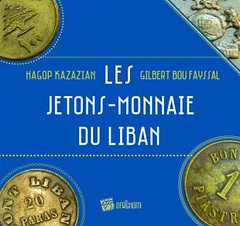 Eli Aharoni, Numismatica Catalog for Collectors, coins, banknotes, medals, stamps, tokens, payment methods, pins & Biblical coins (No. 19)
2015. Tel Aviv, The Author, 2015. Pp.287, illus., cover price 160 New Israeli Sheqels, Post Office Box 3381, Tel Aviv 61033, Israel.
Eli Aharoni, Numismatica Catalog for Collectors, coins, banknotes, medals, stamps, tokens, payment methods, pins & Biblical coins (No. 19)
2015. Tel Aviv, The Author, 2015. Pp.287, illus., cover price 160 New Israeli Sheqels, Post Office Box 3381, Tel Aviv 61033, Israel.
Hagop Kazazian and Gilbert Bou Fayssal, Les Jetons-Monnais du Liban. Beirut, Dergham, 2014. Pp. 144. Info at: http://www.dergham.com/book--149
The Lebanese book can be purchased here:
Les jetons-monnaie du Liban (www.antoineonline.com/Book_Les_JetonsMonnaie_Du_Liban_by
_Hagop_KazazianGilbert_Bou_Fayssal_9789953579597.aspx?
productCode=0009789953579597)
NEW BOOK: KEEP THE CHANGE
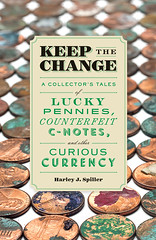 Keep the
Change A Collector’s Tales of Lucky Pennies, Counterfeit C-Notes, and other Curious Currency
Keep the
Change A Collector’s Tales of Lucky Pennies, Counterfeit C-Notes, and other Curious Currency
Harley J. Spiller
5.5 X 8.5 IN / 14 X 22 CM
112 PP / 48 COLOR
PAPERBACK ORIGINAL
978-1-61689-256-2
$19.95 / £12.99
PUBLICATION DATE: APRIL 2015
Harley J. Spiller began collecting money at age five when, home sick from school, his father tossed him a sack of pennies and a Whitman coin folder. In the five decades since, Spiller has amassed one of America’s most extensive collections of unusual financial artifacts as well as a wealth of anecdotes and quirky historical details about US currency. He says, “I see my collection as a cache that cannot be counted in standard ways. It’s not about money; it’s about what can be learned from money.”
In time for tax day, Princeton Architectural Press publishes Spiller’s Keep the Change (April 2015, $19.95). Readers learn why greenbacks are green, what happens to worn-out bills, how artists navigate the fine line between art and mutilation, and whether it’s ever acceptable to burn money. Broken into bite-sized chapters on banknote errors, coin clipping, legal restrictions, counterfeiting, slang terms, and more, Keep the Change is illustrated with vivid photographs of Spiller’s collection. The book is also peppered with true anecdotes like The Bank Manager Who Throws Away a Grand a Year. This highly selective tour through currency legends and lore will inspire readers to look with a new sense of wonder at the bills that pass through our hands every day.
Inspector Collector
 Holds the
Guinness World Record for the world’s largest collection of restaurant menus
Holds the
Guinness World Record for the world’s largest collection of restaurant menus- Cited by Art & Antiques magazine as one of the nation’s “Top 100 Collectors”
- His newsstand paperweight collection is a permanent installation at The New York State Museum
- Twice named “Exhibitions of the Year” by Art in America
- Appeared with Mr. T on Jimmy Kimmel Live
Harley Spiller aka Inspector Collector™ is a professional museum educator who presents his international collections to inspire the lifelong love of learning. His award-winning collections of restaurant menus, flags, maps, spoons, and more have been exhibited in museums around the world, from The Smithsonian Institution to El Museo de Bellas Artes in Caracas, Venezuela. His work has been featured in The New York Times, The Wall Street Journal, and the New Yorker. Numerous television credits include appearances as host, guest, and announcer for diverse shows like The Learning Channel, To Tell The Truth, MTV, VH1, and CNN Headline News.
Inspector Collector’s passion for collecting everyday objects was sparked when he handled President George Washington’s spoon during a high school internship at The White House in Washington, DC. He has gone on to present museum studies courses for the past thirty years, in public and private schools across the globe. Recently, Spiller contributed to the books Street Art 365 (Abrams 2011) and Gastropolis: Food and New York City (Columbia University Press 2008), and The New York Times published his editorial on collecting in 2010. Spiller holds a BA in English Literature from Northwestern University and an MA in Liberal Studies with Honors from The New School for Social Research.

ANS NAMES PUBLICATIONS DIRECTOR, PLANS DIGITIZATION
 Andrew
Reinhard began his tenure as the Director of Publications at the ANS in December 2014, and is already beginning to implement new initiatives. In
2015, the ANS Magazine will appear for the first time in both print and digital editions. The same is true of all forthcoming monographs and
the American Journal of Numismatics.
Andrew
Reinhard began his tenure as the Director of Publications at the ANS in December 2014, and is already beginning to implement new initiatives. In
2015, the ANS Magazine will appear for the first time in both print and digital editions. The same is true of all forthcoming monographs and
the American Journal of Numismatics.
“We’re not doing away with print,” Reinhard said. “Far from it. The goal in going digital, however, is to give readers as many options to access scholarship as possible. Producing eBooks and a digital edition of the magazine and journal make information both searchable and portable.”
Reinhard is no stranger to digital publication. Prior to coming to the ANS, he was the Director of Publications for the American School of Classical Studies at Athens (ASCSA) where he published print and digital archaeology monographs and journal, developed apps for phones/tablets for tourists to use at the Athenian Agora and Ancient Corinth, introduced Google Glass as a serious excavation tool, and made many of the ASCSA’s out-of-print publications available for free as Open Access.
“I hope to do much of the same here at the ANS,” Reinhard said. “We’re in discussions now with JSTOR about scanning the first and second series of the AJN as well as Museum Notes and other periodicals so that the complete run will be available online beginning in 2016. I’m also working on an exciting coin app project that I hope we’ll be able to announce formally later in the year.”
Reinhard graduated with an M.A. in archaeology and art history from the University of Missouri – Columbia in 1996, and has excavated in Greece, Italy, Illinois, and Kansas. He most recently led the excavation of the “Atari Burial Ground” in Alamogordo, New Mexico for the documentary film, Atari: Game Over, and has a television series in development on media archaeology. He was also accepted to the archaeology Ph.D program at the University of York where he is writing on the intersection of archaeology and video games. His research into video game numismatics and virtual currency will appear in ANS Magazine 2015.1.
Other ANS digital projects include the recently completed Coinage of the Roman Republic Online (CRRO) – the companion to 2013’s Online Coins of the Roman Empire (OCRE) – the uploading of the ANS’ Seleucid Coins, Inventory of Greek Coin Hoards, the scanning/cataloguing/linking of the ANS’ auction catalogues, a relaunch of the ANS website, and much more.
On the print side of things, 2015 will be a banner year for books with the following eight titles likely appearing before year’s end: Medallic Art of the American Numismatic Society (Miller), Kushan, Kushan-Sasanian, and Kidarite Coins (Jongeward and Cribb), Irritamenta: Numismatic Treasures of a Renaissance Collector (Cunnally), Monuments in Miniature (Elkins), Festschriften for Richard Witschonke and Basil Demetriadi, Persian Banknotes (Bonine), and the new edition of Tudeer’s The Tetradrachm Coinage of Syracuse in the period of the Signing Artists (Fischer-Bossert/Wartenberg).
Reinhard will be spreading the word about digital and print initiatives throughout the year. “I look forward to being a part of INC in Taormina, Italy for the first time, and in showcasing the work of Ethan Gruber, Oliver Hoover, Andy Meadows and others. It’s a privilege to work with such a talented team and to be able to facilitate the delivery of all of these important, ground-breaking tools for anyone to use for free worldwide. I look forward to continuing that strong, progressive tradition.”
Dr. Ute Wartenberg, the Executive Director, commented on Reinhard’s appointment: “The Society is extraordinarily fortunate to have Andrew as our new Director of Publications. With his background, he will be able to develop our programs of digital and print publications, which were so well developed under Andy Meadows’ tenure.”
To read the complete article, see:
New Director of Publications Electrifies the ANS
(http://numismatics.org/NewsEvents/PR201501150115NewDirPub)
COINAGE OF THE ROMAN REPUBLIC ONLINE

Today, in collaboration with the British Museum and the Münzkabinett of the Staatliche Museen zu Berlin, the ANS launches another major new tool to aid in the identification, research and cataloging of the coins of the ancient world.
Coinage of the Roman Republic Online (CRRO) continues the precedent set by Online Coins of the Roman Empire (OCRE) in presenting, in an easily searchable form, all the varieties of the coinage issued in the Roman Republic. Six online collections containing over 20,000 specimens of Roman Republican coinage spread across 2,300 coin types, in addition to hundreds of hoards from Coin Hoard of the Roman Republic (CHRR) and additional individual findspots provided by Berlin are now available for research.
The site presents a basic description of each published variety based on Michael Crawford’s 1974 publication Roman Republican Coinage (RRC), which remains the primary typology used for the identification of Roman Republican coin types. Since its publication there have been significant revisions to the dating of the series following the discovery of new hoards, but no attempt has been made to reflect these, or to make any other amendments to the published typology at this stage.
The descriptions are based on the typology set out in RRC, but have been modified to meet the standards of the British Museum’s collection management system by Eleanor Ghey and Ian Leins. These were previously published in Ghey and Leins 2010, which forms an update to the 1910 catalogue of the collection by Grueber. Additional types not in the British Museum’s collection were added to this database by Richard Witschonke of the ANS.
Many of these coin types are linked to specimens present in the British Museum’s collection, Münzkabinett of the Staatliche Museen zu Berlin, the ANS, and elsewhere, and where available, to images. Searches are made straightforward through a series of facets, presented in a way that will already be familiar to users of other ANS search tools. Traditional searches of familiar numismatic categories such as obverse and reverse legends and types are provided, as well as the ability to search by deity, in the hope that CRRO will provide an identification tool useful to collectors, dealers, curators, and field archaeologists. Researchers can now list all coin types found within a country and any regional division below the country (E.g., Liguria, down to the town or city).
ANS database developer, Ethan Gruber, says that, "like OCRE and all of our other digital projects at the ANS, CRRO uses Linked Open Data methodologies to aggregate information from disparate institutions and present the information in an interface available in more than 10 languages with advanced mapping and metrical analysis features. CRRO is a fully functional research portal for Roman Republican numismatics."
The ANS acknowledges the contribution of Michael Crawford to the project, and also thanks Michael Sharp of Cambridge University Press for allowing us to use the numbering system of Roman Republican Coinage.
To access Coinage of the Roman Republic Online, see:
http://numismatics.org/crro/
To read the complete article, see:
Coinage of the Roman Republic Online: Something for Roman Numismatists to “CRRO” about
(http://numismatics.org/NewsEvents/PR20150115CRRO)
PORTRAITS OF DECEASED FAMOUS NUMISMATISTS
 The Royal Numismatic Society recently posted this on their Facebook page.
It's fascinating to look at and a great resource. Well worth a look.
The Royal Numismatic Society recently posted this on their Facebook page.
It's fascinating to look at and a great resource. Well worth a look.
Great new resource on Pinterest from François de Callataÿ of the Royal Library of Belgium:
Two databases of portraits of deceased famous numismatists
- those who died before 1800 (falling thus under the scope of the recently launched international project Fontes Inediti Numismaticae Antiquae – FINA)
http://fr.pinterest.com/francoisdecalla/portraits-of-famous-numismatists-1-who-died-before/ (current state: 524 images)
- those who died after 1800
http://fr.pinterest.com/francoisdecalla/portraits-of-famous-numismatists-2-who-died-after-/ (current state: 768 images)
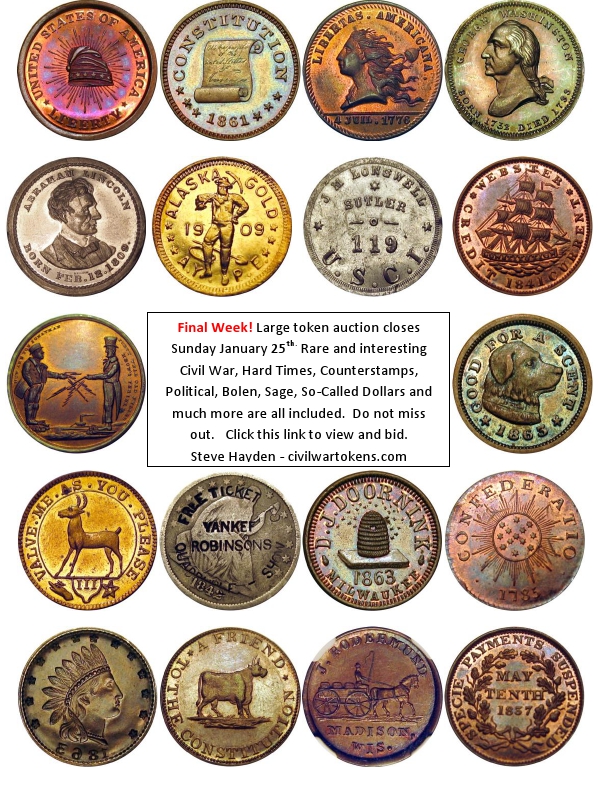
FIVE BOOKS DAVE BOWERS SHOULD WRITE
Dennis Tucker revealed how Dave Bowers writes so many books in last week's E-Sylum. Here is my list of five books I'd like to own and read by Dave.
1. Numismatic Almanac. He has already started this but perhaps other book projects proved a higher priority. Please finish this Dave, as a writer myself I would use it incessantly.
2. Future Coins. With his knowledge of coins, technology and economic factors of the past, he would be highly qualified to project what coins we will be using, say, ten, fifty, a hundred years from now.
3. Chocking Off China's Counterfeits. A list of coins and other numismatic items which are known to have been made in China and suggestions how to stop this damaging activity which could permanently curtail collecting..
4. Restructuring the ANA. As a former officer, president, and always in contact with our national organization, he has rare insight into the inner workings of the American Numismatic Association. If only he could prepare a plan how it should be organized to prevent the problems it has experienced in the past, turn it into the more dynamic organization it should be.
5. Numismatic Immortality. Coins and medals last forever. We have 2,000-year old coins, 500-year old medals and counting. What numismatic items do we have or can create today which will reveal to mankind, say, five hundred or a thousand years from now what kind of people we were, our interests and our activities? Shouldn't we see that these are in selected archival institutions around the globe for a more likely survival? Or, if man has to leave this planet and travel to another what numismatic items should be taken to the new planet and preserved to record our earthly existence? Same thing holds true for our numismatic literature. What numismatic books should be preserved forever?
Dick adds:
I wanted to list ten books for this article, but these are my five most important. Perhaps others would like to add their suggestions.
To read the earlier E-Sylum article, see:
Q. DAVID BOWERS AND NUMISMATIC WRITING (www.coinbooks.org/esylum_v18n02a17.html)
MORE ON MACERATED CURRENCY
Dick Johnson writes:
Does any E-Sylum reader have access to the British publication Strand Magazine? It contained an article on macerated currency in its July 1899 issue (vol 17, page 102). The author was George Dollar (that has to be a pseudonym!).
I have a citation to this article but have never seen it. I would enjoy seeing a photocopy. The reference I saw claimed it mentions that small statues of the U.S. Capitol, the White House and the Washington Monument were made of macerated currency as well as popular U.S. presidents.
W.H. Abbott was the maker of these objects here in America. He is mentioned in Forrer and a few artists references, I include him as the artist of medals bearing the portraits of Washington, Lincoln, McKinley and Theodore Roosevelt in my databank. Fred Reed illustrates the Lincoln medal in his book "The Image of His Greatness" page 172.
Alan V. Weinberg writes:
The largest piece I know of was the macerated currency bust of George Washington (similar to the Houdon Wash. bust). It was three dimensional, approximately 2 feet tall by 1 1/2 feet wide. Rossa and Tanenbaum had it for sale at $5,000 some two decades ago and sold it. Steve Tanenbaum took it to UPS to pack and ship. They did a miserable job of packing it and the bust arrived with its face smashed in. I understand it was re-built and repaired at a cost of $500 according to Steve and subsequently sold for a lot less..
To read the earlier E-Sylum articles, see:
NOTES FROM E-SYLUM READERS: JANUARY 4, 2015 : More On Bert Cohen
(www.coinbooks.org/esylum_v18n01a09.html)
MORE ON BERT COHEN AND MACERATED CURRENCY (www.coinbooks.org/esylum_v18n02a12.html)

THE TRUMAN CONGRESSIONAL GOLD MEDAL


Regarding Greg Ruby's inquiry about the Truman Congressional Gold Medal, there's usually one of the smaller 1.5 inch versions for sale on eBay at any given time. I haven't seen the 3 inch version show up yet; I imagine it will be a hotly contested item when it does.
I think I've written before that there is no good source for information or images of 20th century U.S. Mint medals, which is amazing. The Congressional Gold Medal series is a good example. Medals were struck for luminaries like Frank Sinatra, Bob Hope, Ira Eaker, and General Pershing - I've never seen images of any of those - with most (all?) of the legislation authorizing a particular gold medal providing for bronze copies to be sold to the public. You think it would be easier to find out about them than it is.
Sounds like a research and publishing opportunity for someone. I'm retiring from my government job at the end of the year; might be a fun thing to do if I knew where to start.
To view the complete eBay listing, see:
Harry Truman Centennial Medal 1984
(www.ebay.com/itm/Harry-Truman-Centennial-Medal-1984-/271727589570)
Greg Ruby writes:
 Thanks to Heath MacAlpine for this information. I’ve looked on eBay before, but I guess the timing was not right.
Thanks to Heath MacAlpine for this information. I’ve looked on eBay before, but I guess the timing was not right.
I’ve attached the United Press International picture of Reagan presenting the meal to Margaret Truman, From the way things appear, I don’t think a 3 inch medal was struck as Heath suggested.
Heath’s comments are right on target about the lack of a reliable source for 20th century US Mint medals. If anyone is willing to tackle the project he suggests, the following link would giving a good foundation for the Congressional Gold Medals.
To read the complete article, see:
Congressional Gold Medals, 1776-2014
(www.senate.gov/CRSReports/crs-publish.cfm?pid=%270E%2C*PL%5B%3C%230%20%20%0A)
To read the earlier E-Sylum article, see:
NOTES FROM E-SYLUM READERS: JANUARY 11, 2015 : Query: Truman Congressional Gold Medal Images
Sought (www.coinbooks.org/esylum_v18n02a09.html)
NOTES FROM E-SYLUM READERS: JANUARY 18, 2015
Alex Clain-Stefanelli
Douglas Mudd, Curator/Director of the Edward C. Rochette Money Museum at the American Numismatic Association writes:
I was saddened to hear of Alex Clain-Stafanelli’s death – in my years working with his mother I got to know him a little – he was a kind man dedicated to his mother and to education.
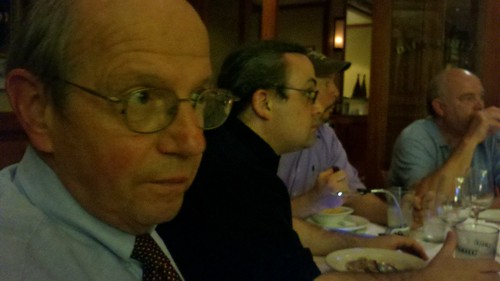
Alex Clain-Stefanelli, Eric Schena, Tom Kays, Mike Packard
To read the earlier E-Sylum article, see:
ALEXANDER A. CLAIN-STEFANELLI, 1943 - 2014 (www.coinbooks.org/esylum_v18n02a06.html)
Can Monkeys Balance a Budget?
Regarding the monkeys being trained to use money, Chip Howell writes:
I'll be interested in a follow-up to see if monkeys can be taught to balance a budget, and if the instruction program can be adapted to our legislature.
To read the earlier E-Sylum article, see:
PSYCHOLOGIST TRAINS MONKEYS TO USE MONEY (www.coinbooks.org/esylum_v18n02a26.html)
Boston Time Capsule Coin Inventory
Charles Morgan writes:
Published reports on the Boston Time Capsule have some erroneous information. Hubert Walker's version is the most accurate to date.
According to Lily Rothman in a January 6 piece for Time magazine, the Paul Revere-era time capsule unearthed and opened recently in Boston isn’t technically a “time capsule”. In the article, expert William E. Jarvis–who literally wrote the book on time capsules with his Time Capsules: A Cultural History (2002)–insists that a true time capsule must have a “dig-up-by” date. Items like the one excavated from the cornerstone of the Massachusetts State House on December 11, 2014 are called “foundation deposits”, a tradition that comes down to us from the most ancient past.
But enough of that. You’re here for the coins.
To read the CoinWeek article, see:
Coins, Other Contents of Boston Time Capsule
Revealed (www.coinweek.com/us-coins/silver-coins/coins-contents-boston-time-capsule-revealed/)
To read the earlier E-Sylum article, see:
BOSTON TIME CAPSULE OPENED (www.coinbooks.org/esylum_v18n02a08.html)
Still looking for Superior Photo of O-130 Half Dollar
Chuck Heck writes:
In response to Mr. O'Connor's request --- unfortunately, my second edition Overton does not have a copy of the requested photo. Sorry that I cannot help.
To read the earlier E-Sylum article, see:
SUPERIOR PHOTO OF O-130 1795 HALF DOLLAR SOUGHT
(www.coinbooks.org/esylum_v18n02a10.html)
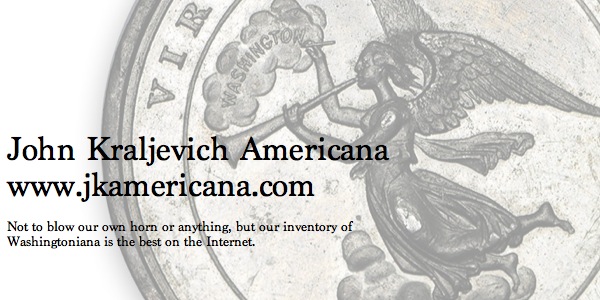
SALLY KIRKA'S NUMISMATIC LITERARY GUILD ELONGATED COINS
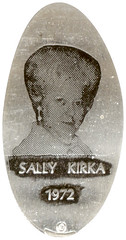 Elongated coin people were among the most important early leaders of the Numismatic Literary Guild, NLG. Think Lee Martin and Dottie Dow,
"Yesterday's Elongateds."
Elongated coin people were among the most important early leaders of the Numismatic Literary Guild, NLG. Think Lee Martin and Dottie Dow,
"Yesterday's Elongateds."
Sally provided a whole series of elongateds for the NLG Bash in the 1980s, doing the actual rolling herself. This was muscle-building labor! She was a remarkable woman, remembered by NLG with fondness.
David T. Alexander, NLG Life Member, Executive Director 1982-1990
N.L.G. Milwaukee Convention Elongated, 1986. 51mm on 1980-D, (most) 1981-D Cents. Vertical. Complete N.L.G. typewriter logo at center, upper legend N.L.G. WELCOMES YOU TO./ (arabesque)/ A.N.A. Below, 95th/ CONVENTION/ AVG 5-9. 1986/ MILWAUKEE, WI./ tiny SAK. Lacquered. Uncirculated. ($15-25)
N.L.G. Milwaukee Convention Elongated, 1986. 51mm on 1981-D Cents. Pierced for wear with red-white-blue pinback ribbon. Unc. ($20-30)
N.L.G. Atlanta Convention Elongated, 1987. 49.5mm on 1981, 1982-D Cents. Vertical, NLG logo as last, NLG WELCOMES YOU TO */ ATLANTA,/ GA., below AUG. 26-30/ 1987/ * A.N.A. CONVENTION/ tiny SAK. Uncirculated. ($15-25)
N.L.G. Cincinnati Convention Elongated Quarter, 1988. 55.5mm Copper-nickel clad copper on 1965, 1967, 1974-P, 1977, 1977-D, 1979-P, 1982, 1981-P, 1983-P, 1984-P, Quarters. NLG logo, 97th ANA CONVENTION/ JULY/ 20-24/ 1988. Below, CINCINNATI/ OHIO/ Arabesque/ WELCOME TO N.L.G. 20th ANNIVERSARY/ SAK. Special denomination for 20th Anniv. Uncirculated. ($35-45)
N.L.G. Cincinnati Convention Elongated Quarter, 1988. 55.5mm Copper-nickel clad copper on 1983-P Quarter, pierced for wear with U.S. flag pinback ribbon. Uncirculated. ($40-50)
N.L.G. Pittsburgh Convention Elongated, 1989. 49.5mm Bronze on 1980-D, 1981, 1982-D Cents. NLG logo as last, 98th A.N.A. CONVENTION/ AUG. 9-13/ *1989*. Below, PITTSBURGH/ PA./ */ WELCOME TO N.L.G. BASH/ SAK. Uncirculated. ($15-25)
N.L.G. Generic Elongated, 1990. 47mm on 1981-D Cents. NLG logo as last, above NUMISMATIC, below. LITERARY GUILD/ FOUNDED/ 1968/ SAK. Uncirculated. ($15-25)
To read the earlier E-Sylum articles, see:
ELONGATED COIN COLLECTOR SALLY KIRKA (www.coinbooks.org/esylum_v18n01a18.html)
NOTES FROM E-SYLUM READERS: JANUARY 11, 2015 : Sally Kirka and Sheldon's Somotypes
(www.coinbooks.org/esylum_v18n02a09.html)
BOOK: 200 YEARS OF BALLOONING IN NUMISMATICS
Jeff Starck of Coin World writes:
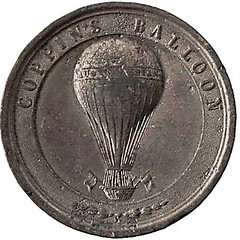 Recently hot air balloons and numismatics were mentioned together in The E-Sylum. There is a gem
of a little book (96 pages) about the topic, called Lighter Than Air, 200 years of Ballooning in Numismatics, by Evelyn Malpas.
Recently hot air balloons and numismatics were mentioned together in The E-Sylum. There is a gem
of a little book (96 pages) about the topic, called Lighter Than Air, 200 years of Ballooning in Numismatics, by Evelyn Malpas.
The book was published by the British Art Medal Society in 1989 and catalogs 461 numismatic items – mostly medals but a few awards and plaques and the like – depicting balloons. A quick check of the American Numismatic Association library catalog confirms that it is available for loan to ANA members. Cheers!
To read the earlier E-Sylum articles, see:
FEATURED WEB PAGE: COPPIN'S 1858 BALLOON MEDAL
(www.coinbooks.org/esylum_v14n05a24.html)
BALLOONING NUMISMATISTS (www.coinbooks.org/esylum_v17n52a15.html)
HOT AIR BALLOONS ON TOKENS (www.coinbooks.org/esylum_v17n53a11.html)

ARTICLE DISCUSSES KEVIN LIPTON'S BIRCH CENT PURCHASE
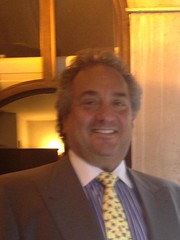 A penny saved for
200 years can earn $2.5 million.
A penny saved for
200 years can earn $2.5 million.
Beverly Hills rare coin dealer Kevin Lipton purchased a rare coin he said is an important piece of American history. He told the Daily News he bought the 1792 Birch Cent penny for $2,585,000 at auction Thursday.
A pretty penny of a sum sure, but Lipton insists he got a good deal and expected the rare coin to sell for far more.
"I wasn't buying it in the heat of an auction," he said Monday from his store, Kevin Lipton Rare Coins. "I was buying it for value."
 The
penny is named after its designer Robert Birch and was a prototype for the nation's first coins, he said.
The
penny is named after its designer Robert Birch and was a prototype for the nation's first coins, he said.
"This coin is one of the greatest, I'd say, top 10 American coins in existence. It's great from a rarity standpoint and a historical standpoint," he said. "It's the birth of our coinage."
A 22-year-old Lipton was actually at the auction in 1981 when the coin was last sold to New York collector Donald G. Patrick for $200,000.
But Lipton said he wasn't interested in the item at the time.
"I didn't understand coins like that back then," he said. "Now I understand the greatest American coins are the ones that represent where we started."
To read the complete article, see:
Beverly Hills coin dealer buys
1792 Birch penny for $2.5 million (www.nydailynews.com/news/national/coin-collector-buys-1792-birch-penny-2-5-million-article-1.2074980)
Alan V. Weinberg writes:
The Unc part red 1792 Birch cent and the Unc 1792 Wright quarter both sold to a blatantly arm-waving Kevin Lipton, underbid by Laura Sperber who likely represented a buyer who, several years ago, reportedly paid $5M for the finest known ex-Garrett 1792 silver center cent. These two Partrick coins are far rarer and nicer and worth more than the Garrett silver center cent. Indeed, an EF Partrick silver center cent sold for all of $400K. hammer.
The prices realized on these two Partrick coins were generally perceived to be absolute bargains and only a few months earlier were predicted to bring almost double what they hammered for: $2.3 and $1.9M.
There was one 1792 pattern, the lesser grade silver disme which was both mis-catalogued and not slabbed properly. While the field tooling-out of the 1792 date was noted, there was no mention anyplace of the extensively re-engraved hair which was apparent at arm's length.
To read the earlier E-Sylum article, see:
PARTRICK 1792 CHALLENGE RESULTS (www.coinbooks.org/esylum_v18n02a07.html)
ARTICLE PROFILES DEALER DON KAGIN
Donald Kagin was pointing at eagles holding tiny arrows. Kagin is a serious man and I was scribbling serious notes. Then he was pointing at an eagle holding a branch, and telling me about the implications of the history of the eagle. His tasseled-loafered, monogrammed-cuffed demeanor cracked into delight—that pure kind you only see every couple years. A little rubbed off. The million dollars’ worth of loot in front of us—part of the largest buried treasure ever found in California—might’ve helped. It was complicated.
I’d come to Tiburon, California, on this Wednesday morning to meet arguably the nation’s most learned numismatist. In preparation I’d become learned on what numismatics is: in brief, the study or collection of coins and bank notes and other currency. Kagin’s father was a numismatist. Kagin and his future wife hit coin shows on dates. As president of Kagin’s, Inc., the oldest family-owned numismatic firm in the U.S., Kagin, who is 64, holds the nation’s first bachelor’s degree in the field—and its sole doctorate. His son and daughter-in-law have tumbled into the family business, too, like quarters down a slot.
Kagin showed me around his small office, in an unlikely location I promised not to divulge. Countless old auction catalogs lined the walls; obscure historic currencies filled the shelves: brick tea, a throwing knife, a wiry elephant’s tail used by tribal chiefs in the Congo. By the front door, nearly waist-high, sat an example of the largest currency in the world, stone money from the island of Yap. “Worth a wife or two at one point,” Kagin noted.
The so-called hobby of kings is a funny mix of deep-dive academic research—stamping techniques, economic theory, the study of leprosy-colony money—and your inner 12-year-old squealing OMG these nickels are worth a fortune! Kagin keeps his squealing inner tween tightly under wraps. Arrayed before us, on a table suitable for lunch, were some head-slappingly valuable coins. Wearing a graying goatee and appraiser’s detachment, he spoke of them with a professorial calm.
“Look at the symbols,” he said, fascinated by those tiny arrows, not a the massive value. “You’ve got the eagle holding arrows, representing force, to preserve these branches of peace over here. Coins and notes are allegory.” Between his 1981 doorstop of a book, Private Gold Coins and Patterns of the United States, and his meticulous one-man show on pioneer gold—yes, Kagin’s second love is theater—he has done his best to translate that allegory.
A phone call last year introduced him to the greatest find of his career. A California couple had gone to walk their dog on their property in the Sierra Nevada. They’d taken this walk countless times before, but on this day the woman noticed a rusty canister sticking out of the ground. What happened next will sound familiar, either from a news report you read at the time or that fantasy you cultivated as a child. Using a stick, the couple managed to dig the canister out. It was heavy; the man figured it held old lead paint. Then the lid slipped off. No, not paint. Gold coins. Many gold coins.
Over the next week, “John and Mary,” as the couple pseudonymously termed themselves, pulled seven more cans of gold from the ground. They were likely stashed there by a 19th-century local with minimal trust in banks. What became known as the Saddle Ridge Hoard comprised 1,427 coins, valued at $10 million. John and Mary kept them in an ice cooler buried under a woodpile in their yard.
Kagin and a colleague heard from John and Mary when the couple sought advice on selling their find. (Kagin is one of the only people who know John and Mary’s true identities.) A good numismatist is many things: a historian, certainly; but also an economist, an archeologist, an anthropologist, a metallurgist, an iconologist, and, in this case, a consigliere. The couple proposed hawking off the coins piecemeal; this turned Kagin into a moneyman in the traditionally remunerative sense. He convinced John and Mary that auctioning all the gold all at once, as a branded hoard, would fetch a higher price.
Kagin described the Saddle Ridge Hoard as “the single greatest buried treasure find in U.S. history” in a voice a notch or two calmer than one would expect. “The drama and mystique were as compelling as the gold itself.” Kagin believes that money tells us more about a civilization than any other type of artifact. “You’re buying the story when you buy a Saddle Ridge piece.”
To read the complete article, see:
For the Love of Money: If
You Happen to Find Buried Treasure, Here’s the Guy to Call
(www.psmag.com/navigation/business-economics/love-money-happen-find-buried-treasure-heres-guy-call-95419/)
BEP CHIEF COUNSEL SIDNEY ROCKE
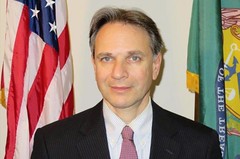 The Bureau of Engraving and Printing (BEP) routinely redeems badly damaged U.S. currency, providing reimbursement of more than $30 million a year on
some 30,000 claims.
The Bureau of Engraving and Printing (BEP) routinely redeems badly damaged U.S. currency, providing reimbursement of more than $30 million a year on
some 30,000 claims.
Periodically, criminal elements have attempted to collect payments for large sums of counterfeit or intentionally mutilated currency by taking advantage of a quirk in the law that required the government, if it suspected fraud and denied reimbursement, to go to court and prove the damaged money was phony.
BEP Chief Counsel Sidney Rocke advised changing the agency’s regulations to place the burden of proof on the suspected swindlers, and drafted regulations requiring them to convince a judge that their mutilated or counterfeit money is real–an action few if any will undertake.
“I revised the regulations to deter this kind of conduct and to make sure that if it does occur, we can deal with it more effectively,” said Rocke. “The change makes the legal terrain much easier in our fight against fraud.”
Rochelle Granat, an assistant general counsel at the Department of the Treasury said, “Sid was the force behind the mutilated currency regulations to protect the government and prevent this type of fraud. He is definitely a change agent and looks at issues in ways to make things better.”
Rocke’s work on such regulatory matters is just one small part of his job, which entails providing legal advice and counsel on a wide range of issues, for an agency that prints billions of dollars a year in U.S. currency and has a workforce that includes blue-collar employees, security specialists, acquisitions personnel, chemists, engineers and its own police force.
On any given day, Rocke and his staff in Washington and Fort Worth, Tex., may be dealing with lawsuits against the agency from those seeking to remove “In God We Trust’ from the currency to a variety of personnel matters involving employees in 19 separate labor bargaining units.
Rocke provides legal advice regarding contracts with suppliers of sophisticated machinery and the paper and chemicals used to make the currency. He handles Freedom of Information Act requests, real estate questions and matters relating to BEP’s internal police force and printing facilities, and he confers with the Secret Service and other law enforcement agencies on criminal investigations.
Recently, he has been helping BEP comply with a court order to provide meaningful access to U.S. currency for the blind and visually impaired. BEP has been seeking to institute multiple accommodations, including distribution of digital currency readers, the addition of tactile features and large high-contrast numerals. The agency has also developed a free app called EyeNote® that can turn any iPhone into a digital reader.
Rocke said the task has not been simple, due to disagreements among the affected groups about the kind of changes that should be instituted and because of technical impediments and manufacturing issues involved in changing the currency. He pointed out, for example, that altering the currency to help the blind, if not done properly, can make it impossible for cash machines to accurately read and calculate the paper notes.
“What I have done is translate the practical concerns into legal words, ensuring that we are complying with the court order, demonstrating our commitment to the advocates and making sure we are meeting our technical specifications and security needs,” said Rocke.
To read the complete article, see:
Attorney helps protect U.S. currency from counterfeiters
(www.washingtonpost.com/politics/federal_government/attorney-helps-protect-us-currency-from-counterfeiters/2015/01/13/bdd14d6e-9ba1-11e4-bcfb-059ec7a93ddc_story.html)
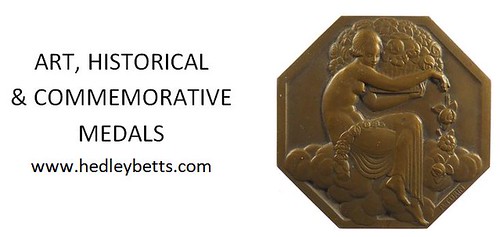
NUMISMATIC SCRAPBOOK CONTRIBUTOR'S MEDAL IMAGES
I enjoyed reading the two articles on the medals given out by Numismatic Scrapbook. I have four of the five medals that were issued. I didn't obtain my medals for writing articles as they preceded my interests in numismatics. The medals are brass, 28mm, all having a common reverse. Attached are scans of these first four medals.

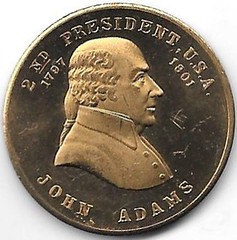
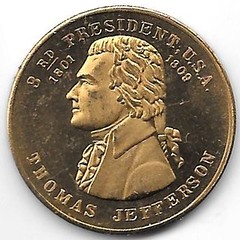
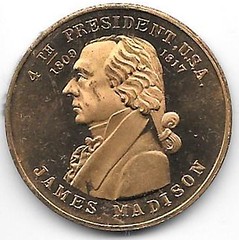
To read the earlier E-Sylum articles, see:
THE NUMISMATIC SCRAPBOOK CONTRIBUTOR MEDAL (www.coinbooks.org/esylum_v18n01a13.html)
NOTES FROM E-SYLUM READERS: JANUARY 11, 2015 : More on the Numismatic Scrapbook
Contributor's Medal (www.coinbooks.org/esylum_v18n02a09.html)
MORE ON THE 1864 BOSTON MASONIC TEMPLE HALF DOLLAR

The description penned by John Pack, with the assistance of John Kraljevich, tells the whole story of this intriguing and rare piece, and the description is quoted below in its entirety: 1864 Boston Masonic Lodge Half Dollar. Rulau Ma-Bo 51, Brunk-26400, page 221. Inscribed to E. Pote. AU-50 (PCGS). Deep steel gray with accents of blue in the fields and lighter gray on the high points of the relief. Hand-engraved with great skill in the obverse fields to "E. Pote" at left, and with "Boston Encampment" at right. The reverse is similarly engraved around the central device, "Taken from the ruins of Masonic / Temple / April 6th, 1864."
These very rare Masonic half dollars were little understood and usually traded as "love tokens" or similar until a fine article by collector and dealer Mark Hotz was published on them in the February 1993 edition of The Numismatist and shed important light on them. The rarity of these coins is such that most collectors have never seen one and are largely unaware of their historic nature.
The Boston Masonic Temple, known at the time as the Winthrop House (named for the distinguished old Boston family), was destroyed by fire in April 1864. Due to the engraving on the coins, it has long been accepted that the fire was April 6th, though the 1866 By-Laws of St. Andrews Royal Arch Chapter at Boston gives the date of the fire as April 5th. It is likely that the actual recovery of the silver was the following day, as stated on the coin.
It was a six-story structure built in 1845 at the corner of Boylston and Tremont streets at the southeast corner of the famed Boston Common. The following is, with permission, reproduced from a description of another such piece written by John Kraljevich, and published on his website, jkamericana.com:
"The fire burned hot and long, and news of it was a story nationwide. Though many priceless artifacts were lost forever, the Temple's leadership was able to salvage the ceremonial silver implements, which they then sent to the Philadelphia Mint and had turned into a specially-struck batch of half dollars. The half dollars were engraved appropriately, with the reverses inscribed 'Taken from the ruins of Masonic Temple / April 6, 1864,' and sold for $1 each as fundraisers.
This, in and of itself, was noteworthy: due to the Civil War, specie payments were suspended, and new silver coins were simply not seen in circulation in the East. Money was scarce in general, and few of these commemorative relic half dollars were issued. By 1871, the specially struck commemorative half dollars for the Boston Masonic Temple were already well known enough to be covered in the American Journal of Numismatics…When Hotz wrote, just two were identified. Since then, a few more have been published, with most estimates of those known focused around a half dozen total pieces."
There are six different pieces listed in Russell Rulau's Standard Catalogue of United States Tokens, including the one sold by Kraljevich earlier this year. The one offered presently is not among them. It has been suggested that the engraving was done at the Mint, as it is finely accomplished and largely uniform in layout. However, this seems highly unlikely as the engraving of coins as mementos was generally the realm of jewelers, while the production of coinage was the sole business of the Mint.
One of the pieces illustrated by Rulau has a differently styled engraving, lending some evidence that more than one party may have been involved. This suggests that the engravings were likely contracted privately, probably in Boston, where the pieces were sold and where there would have been no shortage of skilled engravers and silversmiths ready to accept such a project.
The fact that the personal inscription phraseology differs between coins, and some have no name at all suggests that those who ordered them had some say in how the engravings were completed. This one is engraved to E. Pote, perhaps Elisha Pote. There is little published about him beyond his mention in the 1874 Proceedings of the Grand Commandery of Knights Templars and the Appendant Orders of Massachusetts and Rhode Island.
To read the complete article, see:
Historic 1864 Boston Masonic Temple Half Dollar, Struck from Silver Recovered from the Winthrop House
(www.stacksbowers.com/NewsMedia/Blogs/TabId/780/ArtMID
/2678/ArticleID/64935/Historic-1864-Boston-Masonic-Temple-Half-Dollar
-Struck-from-Silver-Recovered-from-the-Winthrop-House.aspx)
To read the earlier E-Sylum article, see:
1864 MASONIC ENGRAVED HALF DOLLAR (www.coinbooks.org/esylum_v17n23a19.html)
ROYAL MINT UNVEILS £20 WINSTON CHURCHILL COIN
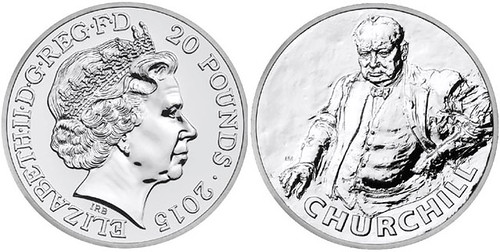
The Royal Mint has unveiled (15th January) the theme of its third United Kingdom “£20 for £20” coin which pays tribute to the great British statesman Sir Winston Churchill. Twice Britain’s Prime Minister, and renowned the world over for his unyielding leadership and formidable character, Churchill is regularly voted as the ‘Greatest Briton’ in public polls.
The Royal Mint invited the Great-Grandson of Sir Winston Churchill to the “first-strike” ceremony. Randolph Churchill 49, the elder son of Sir Winston’s Grandson, also Winston (1940 – 2010) who was named after his famous grandfather, travelled to the Royal Mint’s headquarters in Llantrisant, Wales to attend the ceremony and witnessed the first of the silver £20 denominations rolling of the presses.

After the first coins were minted, Mr. Churchill posed along with the coin’s original plaster cast, used in the process of preparing dies for the minting presses.
The reverse design of the Winston Churchill £20 face value silver coin is by figurative sculptor Etienne Millner, who took his inspiration from the celebrated photograph of Churchill captured by Yousuf Karsh in 1941. The coin bears the current portrait of Her Majesty Queen Elizabeth II on its obverse by Ian Rank-Broadley, which is to be retired this year.
Philip Mernick adds:
I quite like the Churchill design although £20 for half an ounce of silver is no bargain. I hope the Queen looks a bit more cheerful in the promised new design, I have never been that keen on the grumpy IRB portrait.
To read the complete article, see:
Third £20 Face Value Silver Coin Pays
Tribute to Sir Winston Churchill (http://news.coinupdate.com/third-face-value-silver-coin-pays-tribute-to-sir-winston-churchill-4664/)
THE BOOK BAZARRE
ROGER BLAND AWARDED ROYAL NUMISMATIC SOCIETY MEDAL
 Roger Bland (Institute alumnus and Honorary Lecturer) has been awarded the Royal
Numismatic Society's silver medal for 2014.
Roger Bland (Institute alumnus and Honorary Lecturer) has been awarded the Royal
Numismatic Society's silver medal for 2014.
This is the premier international award in its field, and was awarded to Roger both for his own numismatic work and for his achievements in transforming the UK law on antiquities through the Treasure Act 1996 and the Portable Antiquities Scheme, which has just recorded its 1,000,000th object.
The Society's Medal was instituted in 1883, to be awarded annually to ‘some person highly distinguished for services to Numismatic Science’, as elected by the Council.
Roger, who is Keeper of the Departments of Prehistory & Europe and Portable Antiquities & Treasure at the British Museum, undertook his PhD research at the Institute with Richard Reece (who himself received the Royal Numismatic Society medal in 2009) on 'The Coinage of Gordian III from the mints of Antioch and Caesarea'.
Roger is also a recipient of the French Numismatic Society's medal, being awarded this distinction two years ago.

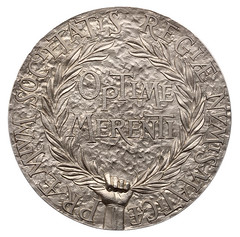
The Fitzwilliam Museum, University of Cambridge, UK
Philip Mernick writes:
I was present at the meeting and Roger showed it to me. It was presented at the December meeting of the RNS held at the premises of Spink & Son. It is an impressive hunk of silver.
To read the complete article, see:
Roger Bland awarded Royal Numismatic Society medal
(www.ucl.ac.uk/archaeology/calendar/articles/2014-15-news/20150112)
- F. Imhoof-Blumer (1888),
- Ernest Babelon (1892),
- Barclay V. Head (1907),
- Edward T. Newell (1925),
- Agnes Baldwin Brett (1943),
- Sydney P. Noe (1949),
- Theodore V. Buttrey (1983),
- Eric P. Newman(1991),
- Mark Blackburn (2008) and
- Alan Stahl (2010).
Mark Blackburn donated his medal to the Fitzwilliam; it's illustrated above. -Editor
The Society’s Medal was instituted in 1883, to be awarded annually to ‘some person highly distinguished for services to Numismatic Science’, as elected by the Council.
The Medal is presented at the Annual General Meeting in December, at which the Medallist will give a lecture.
The dies for the original silver medal were given to the Society by Sir John Evans in 1883. A new cast silver medal commissioned from Ian Rank-Broadley was first presented in 1993.
To read the complete article, see:
The Society’s Medal
(http://numismatics.org.uk/medals-honorary-fellowship-prizes/the-societys-medal/)
To read the Fitzwilliam catalog listing, see:
Royal Numismatic Society Medal
(http://data.fitzmuseum.cam.ac.uk/id/object/197057)
Philip Mernick adds:
There are images of the earlier medal (obverse & reverse) on Google Images. I think it had to be replaced when the die cracked.
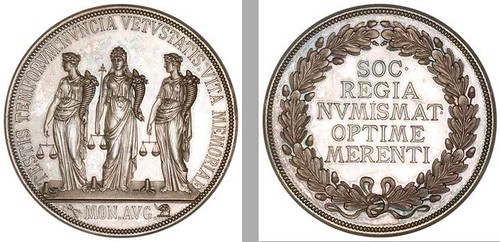
ROOSEVELT MEDALS FASCINATE A COLLECTOR
My January issue of The Numismatist arrived this week with an interesting article on two Theodore Roosevelt Medals. Collector William D. Robertson had researched the first and was looking for more information on the second.
This is. indeed, what I advise any collector to do, as every coin, medal and token has a story to tell. This additional data more than what is obvious on the two sides of piece is called the lore of the specimen. This lore is often what makes our collecting activity so fascinating. Here is what I can add about the medals from my Databank.
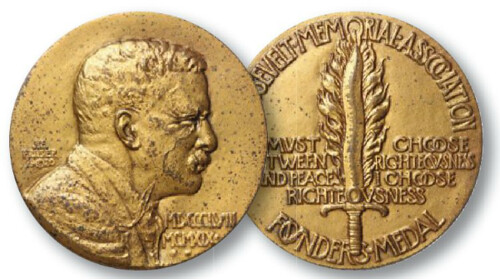
The first, and most attractive medal, was indeed created by James Earle Fraser, which is correct, But neither that medal, nor the second bearing a similar portrait of President Roosevelt had anything to do with the U.S. Mint which was intimated in the last paragraph.
The medal, for the Roosevelt Memorial Association, was called their Founders Medal. It was struck, not by the U.S. Mint, but by Medallic Art Company which had produced most all of Fraser's medallic creations outside the Mint.
It is the firm's catalog number 1929-020, further it was cited in Barbara Baxter's book on the Beaux Art Medal in America as 237. It has appeared more than a dozen times at auction in the last two decades.
 The second medal, which the article's sub-head states "A collector learns that an attractive
uniface medal is not a medal at all" is completely incorrect! The medal again was struck by Medallic Art Company, catalog number 1968-167. The
portrait is the same from that 1920 medal.
The second medal, which the article's sub-head states "A collector learns that an attractive
uniface medal is not a medal at all" is completely incorrect! The medal again was struck by Medallic Art Company, catalog number 1968-167. The
portrait is the same from that 1920 medal.
It was, indeed, to be mounted in the gun stock of a Colt Winchester rifle -- illustrated in the article -- this was one of a long series of medals the firm had produced for Winchester.
The article downplays the type of medallic item. No surprise to medal collectors the piece is firmly considered a medal. Despite the fact it was struck on a coin press, the firm's German Schuller coining press, it is a medal as much as any dollar-size medal with one or two sides.
Now, the research for all this will be accommodated for all, collectors, writers -- and even editors -- shortly. My Databank of 40,000 coins, medals and tokens is weeks away from leaping onto the internet. Such questions for seeking the basic data for all American numismatic items for whom we know their creators will be free on a web site. With a few computer button clicks that info mentioned above will be revealed.
Finally, collector Robertson will be glad to learn, that uniface Roosevelt medal is more rare than the Memorial Medal. Since all were mounted on gun stocks, very few are loose and got into collectors hands.
THE BOOK BAZARRE
THE SCANDALOUS BOHEMIANS OF NEW JERSEY MEDAL
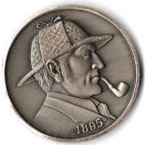

The Scandalous Bohemians of New Jersey had their charter meeting on February 28, 1969 with eight members in attendance.¹ They would later have a irregular newsletter, The Scandal Sheet.
The above medal appears to have been made in 1971. This would make this the oldest item of Sherlockian Numismatica, with the next item coming in 1978 (that’s for another post).
OBVERSE: (Bust of Sherlock Holmes, with deerstalker cap and pip, facing right) / • 1895 •
REVERSE: (violin and bow) / “The Best and the Wisest / Man Whom I Have Ever Known” / JOHN H. WATSON, M.D. / • THE OSTLERS • SBNJ •
32mm, 1 troy oz. .999 fine silver, Round
In reviewing back issues of The Baker Street Journal, we have gleaned the following nuggets:
From the Wants and Offers section of the December, 1971 issue of The Baker Street Journal (Vol. 21, No.4, page 252):
A solid silver (.999 fine) Sherlockian medal, 1 1/4? in diameter, is offered by The Scandalous Bohemians. The obverse bears a profile of the Master and the reverse a suitable quotation by Watson. It will sell for $12., postpaid in U.S. Foreign orders please add 50¢. A limited number of identical coins numbered serially to 100 are also available at $15. Orders for expected delivery in late December are being taken. Cheques should be made out to The Ostlers – SBNJ and sent to Martin J. King, 1113 Sylvan Lane, Mountainside, N.J. 07092.
At the November 19, 1971 meeting of the Scandalous Bohemians of New Jersey, it’s newly appointed Gasogene, Norman Nolan, updated the membership on the status of the Sherlockian coin project.
During the January 5, 1973 William Gillette Memorial Luncheon at Keen’s Chop House, Rev. Henry Folsom presented BSI Commissionaire Julian Wolff with one of the Scandalous Bohemians’ silver Sherlock Holmes medal.
To read the complete article, see:
The Scandalous Bohemians of New Jersey Medal
(http://fourthgarrideb.com/2015/01/the-scandalous-bohemians/)
WAYNE'S NUMISMATIC DIARY: JANUARY 18, 2015
On Monday I received and forwarded several files of pages scanned from The Elder Monthly in response to John McMichael's request. Many thanks to Rick Stroman for scanning his bound volume of The Elder Monthly 1906 - 1908!
Tuesday, January 13, 2015 bought the latest meeting of my northern Virginia numismatic social group, Nummis Nova. Wayne Herndon was our host. I was among the last to arrive and took a seat next to Ron Abler. Soon Julian Leidman took the seat on my other side. Others in attendance were Steve Bishop, Gene Brandenburg, Chris Neuzil, Wayne Herndon, Eric Schena, Joe Levine, and Dave Schenkman.
We were back at Reston Town Center, this time at a French restaurant called Mon Ami Gabi. I was amazed at how packed the place was for a Tuesday night. The food was great and no one had any complaints. I started with French Onion Soup, something I hadn't had in years. My salmon was excellent, as were the mashed potatoes, although I remarked that there must have been a full stick of butter in them, they were so rich.
Centennial Medal for the 'President of the American Parliament"
Ron Abler showed me an amazing 4+ inch bronze medal struck by France for the Centennial Exhibition in 1876. It's rare to see such a huge medal -
impressive! Below is the catalog description, followed by a question from Ron for the E-Sylum readership.
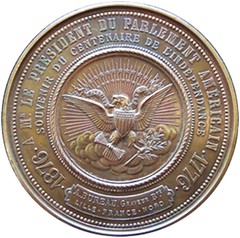
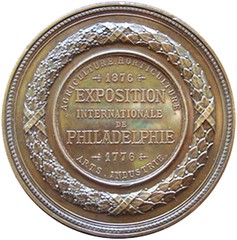
Obverse: In the center, a rendition of the coat of arms of America reminiscent of Dupre’s version on the Diplomatic medal: the spread eagle head right with six arrows in its right claw and an olive branch in its left, bearing a scroll inscribed with the motto “IN PLURIBUS UNUM”; on its chest the escutcheon with thirteen paleways (vertical stripes) and 14 stars on the chief (horizontal band above the paleways); behind, a cloud surmounted by a glory of 53 rays with two bands of stars, 13 in the upper and 9 below; the seal encircled by three rings: solid, rope, and bead; clockwise around from 8:30 in two lines: “A MR. LE PRÉSIDENT DU PARLEMENT AMÉRICAIN / SOUVENIR DU CENTENAIRE DE L’INDÉPENDANCE” [To the President (or Speaker) of the American Parliament / Souvenir of the Centennial of Independence]; below, an ornate curved tablet with “A.BUREAU . GRAVEUR BTE / LILLE• FRANCE • NORD” (From the Bureau of the Mint Bldg / [city of] Lille, Northern France); “• 1776 •” to the right and “• 1876 •” to the left; the whole encircled by a bead chain inside a cove rim; on the edge: the bee symbol of the Paris Mint and “CUIVRE” (bronze).
Reverse: In eight lines, the top and bottom curved: “AGRICULTURE . HORTICULTURE. / 1876 / EXPOSITION / INTERNATIONALE / DE / PHILADELPHIE / 1776 / ARTS . INDUSTRIE .”; encircled by a cove border, outside of which is a dense wreath of oak leaves and acorns left and olive leaves and olives right, bound with a crossed ribbon at the four compass points; the whole encircled by border composed of a single line and a rope border.
Cross-refs: Not listed.
Diameter: 110 mm.
Edge: Lettered
Alloy No.
Bronze 2590bz
Ron adds:
One has to wonder for whom this medal was intended – for the Vice-President, who presides over the Senate, or for the Speaker of the House, Samuel J. Randall, who presides over the House of Representatives, as well as joint sessions of Congress? Interestingly, the office of Vice President was vacant in 1876, because Henry Wilson died in office on 22 November 1875, so Randall would have been acting VP. Thus, the medal apparently went to Randall, but in which capacity?
To read the listing in Ron's Centennial medals catalog, see (scroll to p6): Medals Struck in or by Foreign Countries (http://media.wix.com/ugd/e67427_dbe0c42c6a9e4ee0aa8ecf3f50c406a1.pdf)
August Dittrich Tokens


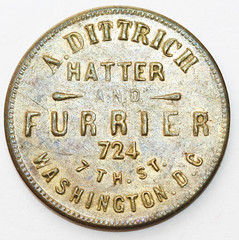

Dave Schenkman brought a nice group of Washington, D.C. tokens and provided the above images. He writes:
After being in business with his brother for a few years, in the mid-1860s August Dittrich opened a store at the address on his tokens. Both are brass, 24mm. The one with the 1875 Liberty head reverse is scarce; the other one is quite rare. They were struck by Dorman’s Stencil & Stamp Works of Baltimore.
I tried to mingle a bit and visit with others at the far end of the table, but it was difficult in such a crowded space. I did little more than say Hi to Chris Neuzil, whom I hadn't seen in a few months. I did get a number of compliments from people on The E-Sylum, including "it's the best publication in numismatics today, bar none." (blush). Well, I try, and like the Beatles, I get by with a little help from my friends. Thanks to Dave Schenkman, Ron Abler and John Feigenbaum (see below) for their assistance with this diary entry,
Newman Numismatic Portal Meetings
 Thursday night brought another numismatic dinner. After work I drove to D.C. and managed to find a parking spot in a lot next to the DuPont Circle
PNC Bank branch, which I believe is an old Riggs bank. I walked over to Pizza Paradiso and put my name in for a table.
Thursday night brought another numismatic dinner. After work I drove to D.C. and managed to find a parking spot in a lot next to the DuPont Circle
PNC Bank branch, which I believe is an old Riggs bank. I walked over to Pizza Paradiso and put my name in for a table.
There would be five of us, and soon the others arrived: Len Augsburger, Roger Burdette, John Feigenbaum of David Lawrence Rare Coins, and Chris Freeland of the Washington University in St. Louis (WUSTL). We'd converged on D.C. for the first face-to-face meeting of the Newman Numismatic Portal project.
Once we got a table and ordered our pizzas, the conversations turned to all of the great things we could do for numismatics with this project. Tens or even hundreds of thousands of books and millions of images digitized and made searchable, starting with Eric Newman's library, which holds many a rare volume.
Afterwards I headed home for the night but returned early Friday morning to get a parking spot. I killed some time working on The E-Sylum at the DuPont Circle Panera Bread (a clean and cozy place). A little before 9am I walked down Massachusetts Avenue. D.C. is a place like no other. Everywhere were foreign embassies, national organization headquarters, and important-sounding buildings.
The local office of WUSTL is in a building emblazoned Carnegie Endowment for International Peace. "How's that working out for ya, Andy?," I thought. Then I chastised myself for being so flippant. War and Peace aren't to be taken lightly, especially in today's environment. Our project is insignificant in comparison, but I was eager to start. I found my way to a conference room on the 7th floor where the others were already in place. John Feigenbaum took this photo to mark the occasion (thanks!):

Len Augsburger, Roger Burdette, Wayne Homren, Chris Freeland
It was a very productive meeting. We worked through lunch and outlined team roles and responsibilities, project goals, and a timeline of intermediate milestones. I think we all came away more excited than ever about where the project could go. Afterwards I walked Len over to the Metro Station before going back to my car. I headed home and worked some more on The E-Sylum after dinner with my family. The rest of the weekend was taken up with basketball games and other family activities, some more E-Sylum work, and entering a bid on a medal on eBay. All in all, a good week. 'Til next time.
To read the earlier E-Sylum articles on the Newman Numismatic Portal, see:
NEWMAN NUMISMATIC PORTAL LAUNCHES IN 2015 (www.coinbooks.org/esylum_v17n51a08.html)
THE HISTORY OF THE COIN LIBRARY (www.coinbooks.org/esylum_v17n51a09.html)

JEFF STARCK REVIEWS EMERGENCY COINAGE
As I wrap up the March World Coins feature about emergency coinage, I was struck at the timeliness for the recent discussion in The E-Sylum about coins that can be traced to the timeframe in which they were produced.
One obvious candidate is a certain subset of coins known as Irish gun money. The halfcrowns, shillings and sixpences bear the abbreviations of the month when they were produced. Irish gun money was an emergency issue under James II as he fought to regain the throne. The coins were to be later redeemed, in order of issuance, after he seized back the throne (which he failed to do).
It is a fascinating area, one discussed at length in multiple references. Here are some images of various dated issues.
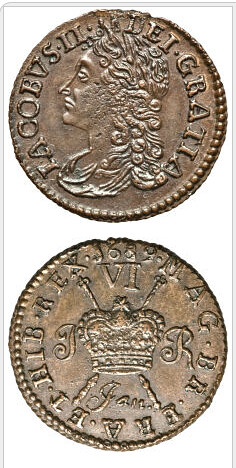

To view the complete Heritage lot description, see:
Ireland:
James II, a premium set of copper Gun Money
(http://coins.ha.com/itm/ireland/world-coins/ireland-james-ii-a-premium-set-of-copper-gun-money-as-follows-total-6-coins-/a/3015-25165.s)
The Emergency Money story will cover a broader range of issues, but Irish gun money is probably the most fascinating aspect in the article, which will be published on Feb. 21.
To read the earlier E-Sylum articles, see:
IRISH GUN MONEY (www.coinbooks.org/esylum_v17n45a35.html)
NUMISMATIC ITEMS DATED BY MONTH (www.coinbooks.org/esylum_v17n46a29.html)
HOWARD GIBBS AND HIS ALASKAN TINNAH
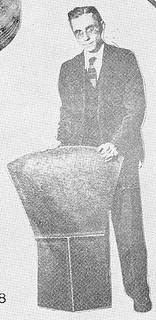 In
response to Dick Hanscom's request, Ken Bressett writes:
In
response to Dick Hanscom's request, Ken Bressett writes:
Attached is the information wanted about the Gibbs auction. The catalog is dated January 26, 27, 1971. It is part III of the Gibbs collection. The printed picture is very poor quality.
Dick adds:
Tinnah or any variation thereof were large copper plates that were exchanged, traded, etc. The one in the photo is not the one in the auction. The one in the auction was larger. Actually, both in the auction were larger than the one shown.
Many times they were given away, destroyed, etc. to show disregard for wealth. The best part was that every time they changed hands, they were worth more. Too bad coins, gold and silver don’t follow that course.
To read the earlier E-Sylum article, see:
NOTES FROM E-SYLUM READERS: JANUARY 11, 2015 : Query: Schulman Gibbs Sale Catalog Sought
(www.coinbooks.org/esylum_v18n02a09.html)
POMPEII WALL PAINTING DEPICTS ANCIENT COIN MINTING OPERATION
Last week, an article about research at Macquarie University's Australian Centre for Ancient Numismatic Studies stated,
There are no surviving contemporary accounts of ancient coin manufacture, and no illustrations.
Bob Van Arsdell writes:
There ARE ancient illustrations of minting operations. Attached is an old postcard (from a set) showing the wall paintings at the House of the Vettii in Pompeii.
The scene shows cupids engaged in various minting activities – including striking coins with a hammer and tongs. I don't know how old the post card is, my guess it was produced well before WWII.
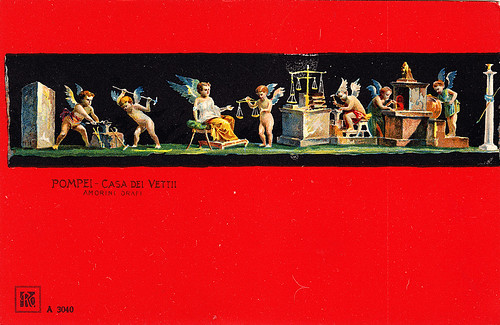
To read the earlier E-Sylum article, see:
MACQUARIE UNIVERSITY INVESTIGATES ANCIENT COIN MANUFACTURING
(www.coinbooks.org/esylum_v18n02a24.html)
SOME RECENT COIN DESIGNS: JANUARY 18, 2015
Poland Coin on the centenary of Warsaw Polytechnic
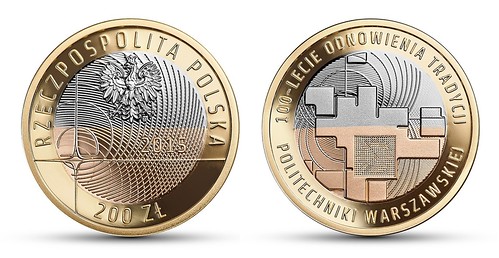
Austria Coin on Cosmology
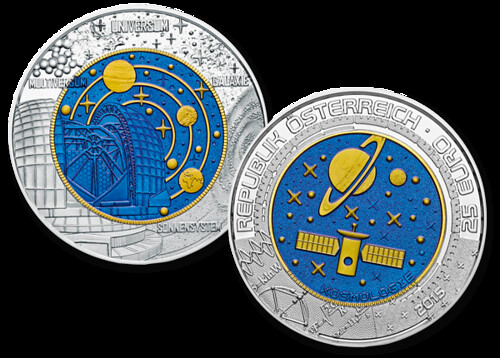
Hungary 2000 Forint Coin on Istvan Homoki-Nagy
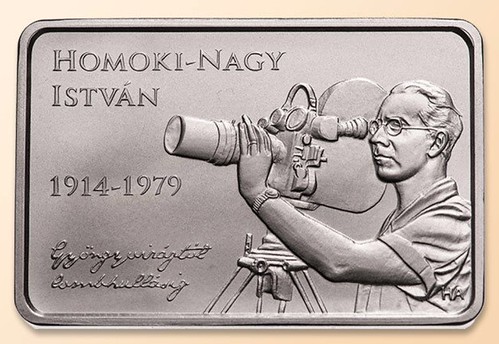

István Homoki-Nagy (Mezotúr, 2 September 1914 - Budapet, 14 December 1979) was a film director, cinematographer, ornithologist, lawyer, pioneering figure in nature documentary, and a Kossuth Prize winning artist. To mark the 100th anniversary of his birthday, the National Bank of Hungary issued a collector coin, designed by Andrea Horváth. The front of the rectangular coin shows the director at work, with a relief of the three animal characters of his film "Buddies", Fickó (a Hungarian vizsla), Pletyka(a dachshund) and Nimród(a falcon) on the back.
Bulgaria 10 leva Coin on Bulgarian Cinema
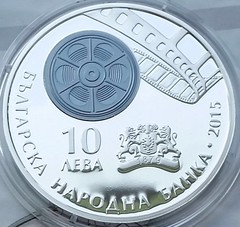

Finland 5 euro Coin on Satakunta Province

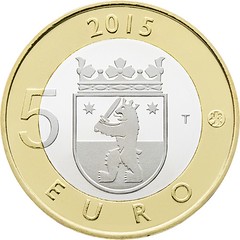
HISTORIAN PANS MAGNA CARTA COIN DESIGN
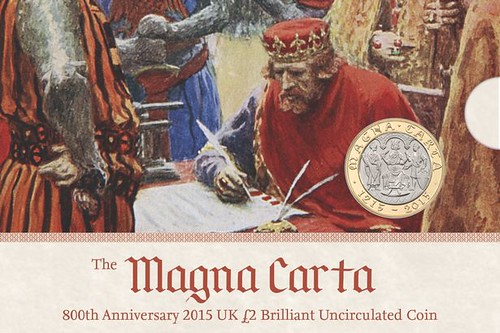
The design of a commemorative coin depicting King John at Runnymede Meadows holding a quill has been labelled a "schoolboy error" by a medieval historian.
The 800th Anniversary of Magna Carta 2015 UK £2 Brilliant Uncirculated Coin, by The Royal Mint, has been designed by an experienced coinage artist, John Bergdahl, and is struck with the king flanked by a bishop and a baron.
But historian Marc Morris has said the scene is historically wrong and has published a more accurate version of the event using Playmobil figures.
“To depict King John holding a quill is simply a schoolboy error,” said Marc Morris, author of King John: Treachery, Tyranny and the Road to Magna Carta.
“Medieval kings did not authenticate documents by signing them, they did it by sealing them - or rather by getting one of their officials to do it for them.
“All the pen in John’s hand symbolises is ignorance of this basic fact.”
The Royal Mint has a long tradition of marking significant moments in history and has been making currency for the Kings and Queens of the country for over 1,100 years.
A spokesman defended the piece, claiming it was symbolic rather than factual.
They said: “The design is symbolic of King John’s acceptance of the Magna Carta, it is not intended to be interpreted as a literal account of what actually occurred.
“The design is in fact inspired by King John’s royal seal, the very seal used on the Magna Carta.”
“I wanted to include the figures who would have been key players in the formation of the Magna Carta at Runnymede,” said the artist.
“I was influenced by the art of the medieval period, which was quite uncomplicated and crude, and the ornate cornice and rose carvings echo the architecture of the era reflecting the time the Magna Carta was created.
“The inscription uses medieval-style font that surrounds the design as the inscription on King John’s royal seal did in the middle ages.”
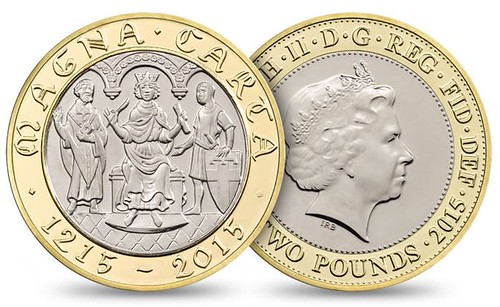
To read the complete article, see:
Magna Carta commemorative coin labelled
historically wrong by medieval historian (www.getsurrey.co.uk/news/surrey-news/magna-carta-commemorative-coin-labelled-8423772)
To read the earlier E-Sylum article, see:
THE ROYAL MINT'S MAGNA CARTA COIN (www.coinbooks.org/esylum_v18n01a20.html)
THE BOOK BAZARRE
ROYAL MINT'S BIG BEN COIN SELLS OUT
 Big
Ben has been sold for £100 – or at least the commemorative coins created by the Royal Mint have.
Big
Ben has been sold for £100 – or at least the commemorative coins created by the Royal Mint have.
All 50,000 of the first ever £100 for £100 silver coin have been snapped up within days of their release by The Royal Mint at Llantrisant.
Some of the coins had already found their way onto auction website eBay, with prices of up to £999.
Laura Clancy and Glyn Davies, the Royal Mint’s in house engravers were responsible for designing the image for the coin.
It is the third such commemorative coin to be released after the £20 and £5 coins which celebrated the birth and first birthday of Prince George of Cambridge.
Director of Commemorative Coin and Medals, Shane Bissett, said: “The sound of Big Ben chiming in the Elizabeth Tower is one which is synonymous with Britain for millions of British citizens and tourists alike, particularly on New Year’s Eve.
“We thought that this British icon was a fitting choice for the nation’s first £100 for £100 coin, and that the New Year would be a fitting time to reveal it.
“We have been thrilled with the fantastic feedback and unprecedented interest from our customers and the UK general public.”
On New Year’s Day they announced coins produced this year will represent “a snapshot of Britain through time” marking some of the UK’s historic events – from the 800th anniversary of the Magna Carta being issued by King John, to the 75th anniversary of the Battle of Britain when outnumbered allied air crews fought off Hitler’s Luftwaffe.
To read the complete article, see:
All 50,000 of the Royal Mint's new £100 coins have sold
out with some already appearing on Ebay (www.walesonline.co.uk/news/wales-news/50000-new-100-coins-sold-8433243)
To read the earlier E-Sylum articles, see:
ROYAL MINT MAKES BIG BEN £100 COIN (www.coinbooks.org/esylum_v18n01a19.html)
NOTES FROM E-SYLUM READERS: JANUARY 11, 2015 : More on the Big Ben Coin Design
(www.coinbooks.org/esylum_v18n02a09.html)
SALES OF PHYSICAL BOOKS SURGE; E-BOOKS LAG
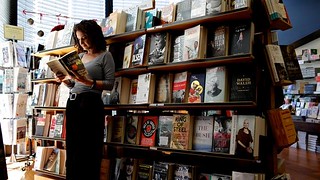 Bookstores
vanishing, e-books surging and all power to Amazon. That has long been the narrative of the publishing industry, with thousands of once-loved shops
disappearing from high streets on both sides of the Atlantic.
Bookstores
vanishing, e-books surging and all power to Amazon. That has long been the narrative of the publishing industry, with thousands of once-loved shops
disappearing from high streets on both sides of the Atlantic.
Waterstones, the UK's biggest remaining book chain, seemed to endorse the shift to digital two years ago, when it started selling Amazon's Kindle e-readers in an attempt to break even. At the time, PwC, the professional services firm, ordained 2015 as the year that e-books would overtake physical books by numbers sold in the UK.
But the plot has twisted sharply, with publishers and book chains in the US, UK and Australia celebrating sales figures showing the resilience of physical editions and of bricks-and-mortar stores.
Waterstones said its sales had risen 5 per cent in December compared with the previous year –no thanks to the Kindle, sales of which "disappeared to all intents and purposes", according to James Daunt, chief executive. "Things are tough, but we have reached the bottom of the market," said Sam Husain, chief executive of Foyles, Waterstones' smaller rival. His company reported an 8 per cent rise in sales, despite its disappointing e-reader experiment.
The optimism was echoed in the US. Barnes & Noble appears to have ended a run of declining sales, and expects sales to be flat in 2014 and 2015. Its shares rose 5 per cent on the news. The change in mood comes after an anxious year for publishers, whose long-term profitability appeared in doubt during a bitter pricing spat between Amazon and French house Hachette. Amazon, the world's largest bookseller, has sought to use its scale to determine e-book prices, while promoting self-publishing, which cuts out traditional middlemen.
"The health of the books industry is pretty good," said Richard Kitson, commercial director of Hachette UK.
Overall the number of physical books sold in the US rose 2.4 per cent last year to 635 million, according to Nielsen Book-Scan, the second successive annual rise. In the UK, physical book sales fell 1.3 per cent –an improvement on the 6.5 per cent fall in 2013, despite the lack of a breakout hit to follow Fifty Shades of Grey or the autobiography of Sir Alex Ferguson, the former manager of Manchester United football club. Sales continued strongly this year.
Meanwhile, the growth of e-books continued to fade in the US and UK, and fewer new e-readers –which are crucial for the spread of digital reading –were apparently given at Christmas.
A recent survey by Nielsen found teenagers prefer print books, with fewer of those aged 13 to 17 buying e-books than their older peers. It suggested that parents' preference, or teens' lack of credit cards for online shopping, could be responsible. "But another explanation may be teens' penchant for borrowing and sharing books rather than purchasing them, which is easier to do in print," Nielsen said. Publishers have also tweaked their approach to print. They have invested in illustrated editions for less price-sensitive consumers, while cutting prices of romance and science-fiction, whose readers are more likely to opt for e-books and self-published works.
In predictions to be released next week, Deloitte will estimate that print will account for 80 per cent of all global book sales in dollar terms this year –and "to generate the majority of books sales for the foreseeable future".
That contrasts with previous industry expectations that e-book sales would soon become at least half of the market. "Everyone thought it would level out at 50-50. It's looking today like it'll be more like 60-40," said Larry Findlay, managing director of Transworld Publishers.
A key factor appears to be the stagnation in sales of e-readers, which have not become as ubiquitous as smartphones and tablets. Amazon does not disclose sales figures for its Kindle e-readers. But Gartner, the research firm, estimates that sales of the devices peaked in 2011, with owners having little reason to upgrade to new models, and other consumers opting for multifunctional tablets instead.
To read the complete article, see:
Books resilient as readers remain true to type
(www.afr.com/p/world/books_resilient_as_readers_remain
_Xq2IloeMMg5YLkBQi1KCPM)

EMPEROR NORTON'S TELEVISION APPEARANCES
For the final hour or so of the event, we'll be screening two rarely seen television episodes — a 1956 episode of Death Valley Days and a 1966 episode of Bonanza — that interpret the story of Emperor Norton.
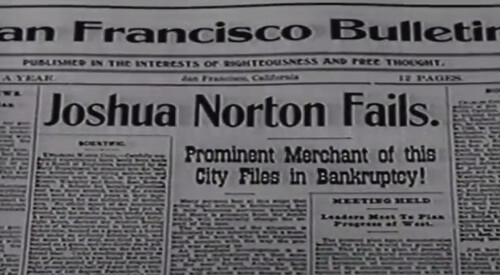
To view the Death Valley Days episode, see: Death Valley Days - Emperor Norton (https://www.youtube.com/watch?v=k3aAhzfcFsM)

To view the Bonanza episode, see:
Bonanza : The Emperor Norton S7 E23 (www.youtube.com/watch?v=PrTQx_3HTBI)
To read the complete article, see:
CAMPAIGN NOTE NO. 8 FUNDRAISER ON 3
FEBRUARY! >>> (http://us3.campaign-archive1.com/?u=2f0cb316ddd8eb026fe43ec9c&id=ce3ac0c5ac&e=1b9e958a43)
TWO DOLLAR BILLS FOR THE YEAR OF THE GOAT
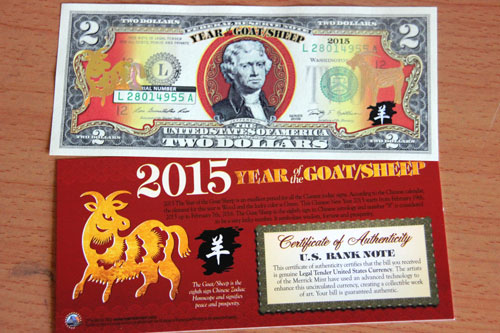
Many Vietnamese have been buying bank notes, souvenirs and interior decor items with a goat-like shape or images of a goat, preparing to welcome the new lunar year, the year of the goat.
Many collection shops in Hanoi have begun taking orders for $US2 bank notes with the image of a goat issued by the US Treasury. On eBay and Amazon, the special version of the US $2 banknote is offered at $13-15, or VND300,000-350,000, which does not include the shipping fee.
In Vietnam, one banknote is sold for VND400,000-500,000. Nguyen Van Linh, the owner of Shoptien.com, said he has taken orders from 300 customers and the first banknotes will be available on January 15.
Linh explained that the banknotes will be brought to Vietnam by the shop’s staff. However, as every traveler can bring only 100 such banknotes, the number will be limited.
“In general, customers have to wait two to three weeks to get deliveries,” he said. “I think I will sell 3,000 banknotes from now to Tet.”
The 2-dollar banknotes with the US President image have also been in high demand, offered at VND350,000. Meanwhile, a 2-dollar plastic gold-plated banknote is cheaper, at VND25,000. Nepali Ruppee with the images of goat and Mount Everest is sold at VND100,000, while one Australian dollar is VND250,000.
Howard A. Daniel III writes:
I have seen similar items but not that exact one. I am giving out a current Lao 1000 Kip note I just picked up there from the central bank in a pack of 100. They are worth about 20 cents each face value but they happen to be replacement notes so they sell in the USA for about US$5-10 each. The paper money collectors I meet with every Sunday morning will love them. I also have US$1 presidential coins for the coin collectors. And I bought some packets of Lao stamps and a few covers for the philatelists who attend the meetings. We will have our annual Tet Lunar (not Chinese!) New Year dinner in a couple of weeks. It reminds me of our Nummis Nova dinners and how much I miss them.
To read the complete article, see:
Products shaped like goats
sell well for Lunar New Year (http://english.vietnamnet.vn/fms/society/120956/products-shaped-like-goats-sell-well-for-lunar-new-year.html)
"BLACK JESUS" DISTRIBUTES COUNTERFEIT MONEY
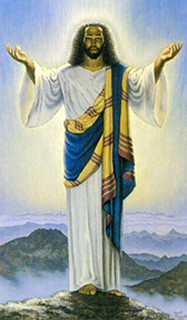 Restaurant patrons
caught trying to pay a bill with counterfeit currency told Florida police that they apparently had received the fake paper as a Christmas gift from
“Black Jesus.”
Restaurant patrons
caught trying to pay a bill with counterfeit currency told Florida police that they apparently had received the fake paper as a Christmas gift from
“Black Jesus.”
After enjoying a January 1 seafood dinner at a Long John Silver’s in Bradenton, a customer sought to pay for his group’s meal with a counterfeit bill, according to a police report. However, an alert cashier recognized the phony currency and called cops.
When Deputy Sinclair Cason arrived at the eatery around 9:15 PM and questioned the customers, they were “cooperative and were unaware of the authenticity of the currency.”
During further questioning, they told Cason that “apparently the bill was given to them as a gift for Christmas from an individual” known to them as “Black Jesus.”
The phony bill was seized by Cason and booked into evidence. The Long John Silver’s customers--who denied knowing that the bill was fake--were not charged in connection with the counterfeit currency. The restaurant tab apparently was settled with legal tender.
The police report does not further describe the relationship between the diners and “Black Jesus,” or why “Black Jesus” was giving them cash for Christmas. Nor does it offer a physical description of “Black Jesus.” Though a beard seems likely.
To read the complete article, see:
"Black Jesus" Blamed For Handing Out Funny
Money As Christmas Gift (www.thesmokinggun.com/buster/black-jesus/bad-paper-from-black-jesus-908651)
'IN DOG WE TRUST' RUG FOR SALE
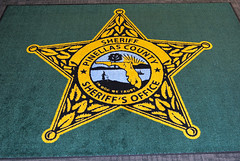 The rug at a Florida sheriff's department might have been better suited
for an animal shelter. The plush green carpet proudly displayed the crest of the Pinellas County Sheriff's Department, emblazoned with its name
and a picture of the state of Florida. Unfortunately, it also contained a small but disastrous spelling error: The words "In Dog We Trust,"
rather than "In God We Trust," the official motto found on US currency and on many government seals.
The rug at a Florida sheriff's department might have been better suited
for an animal shelter. The plush green carpet proudly displayed the crest of the Pinellas County Sheriff's Department, emblazoned with its name
and a picture of the state of Florida. Unfortunately, it also contained a small but disastrous spelling error: The words "In Dog We Trust,"
rather than "In God We Trust," the official motto found on US currency and on many government seals.
It took workers at the office a few months to notice the typo, which appears in fine print on the rug. Now they're looking to sell the defective floor covering for a good cause. "The Pinellas County Sheriff's Office will not 'sweep anything under the rug'," it said in a statement. "Due to extensive inquiries regarding the plans for the 'doggone' rug, the Sheriff's Office has placed the item up for bid and will donate 100% of the bid to Canine Estates Incorporated, a local animal rescue," said the sheriff's department, The office has ordered a new rug which they hope will be error-free.
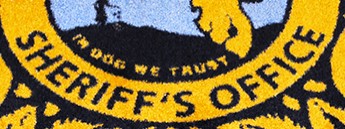
To read the complete article, see:
'In dog we trust' rug put on auction in
Florida (http://artdaily.com/news/75809/-In-dog-we-trust--rug-put-on-auction-in-Florida#.VLvFGSsVhYF)
FEATURED WEB PAGE: DIGITAL LIBRARY NUMIS
This week's Featured Web Page is Digital Library Numis. We have highlighted this site at least twice before, but it's high time to revisit it. From the site:The purpose of the project Digital Library Numis (DLN) is to establish a major portal and digital repository for open access, e-books and e-papers, regarding coins and medals, the history of money, and otherwise related subjects.
The core body entails a broad variety of many rare and often beautifully illustrated numismatic classics produced from the 16th until the early 20th century. but we also offer an extensive survey of contemporary numismatic publications.
Digital Library Numis is particularly useful as an additional research tool for professional numismatists, other academics interested in the field, branch libraries and coin collectors.
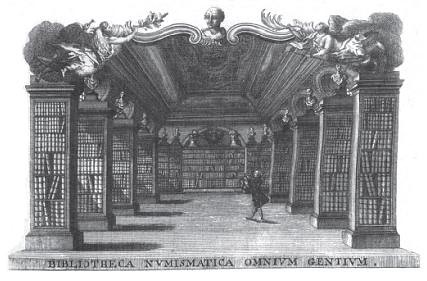
sites.google.com/site/digitallibrarynumis/

